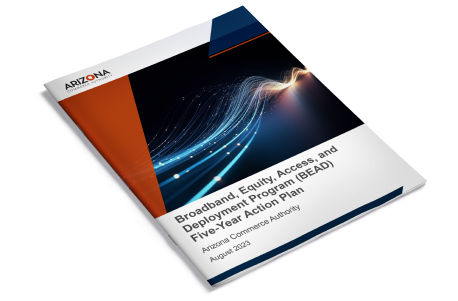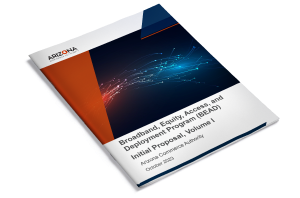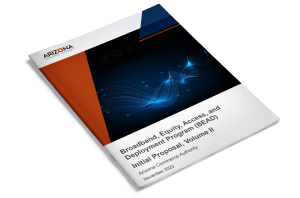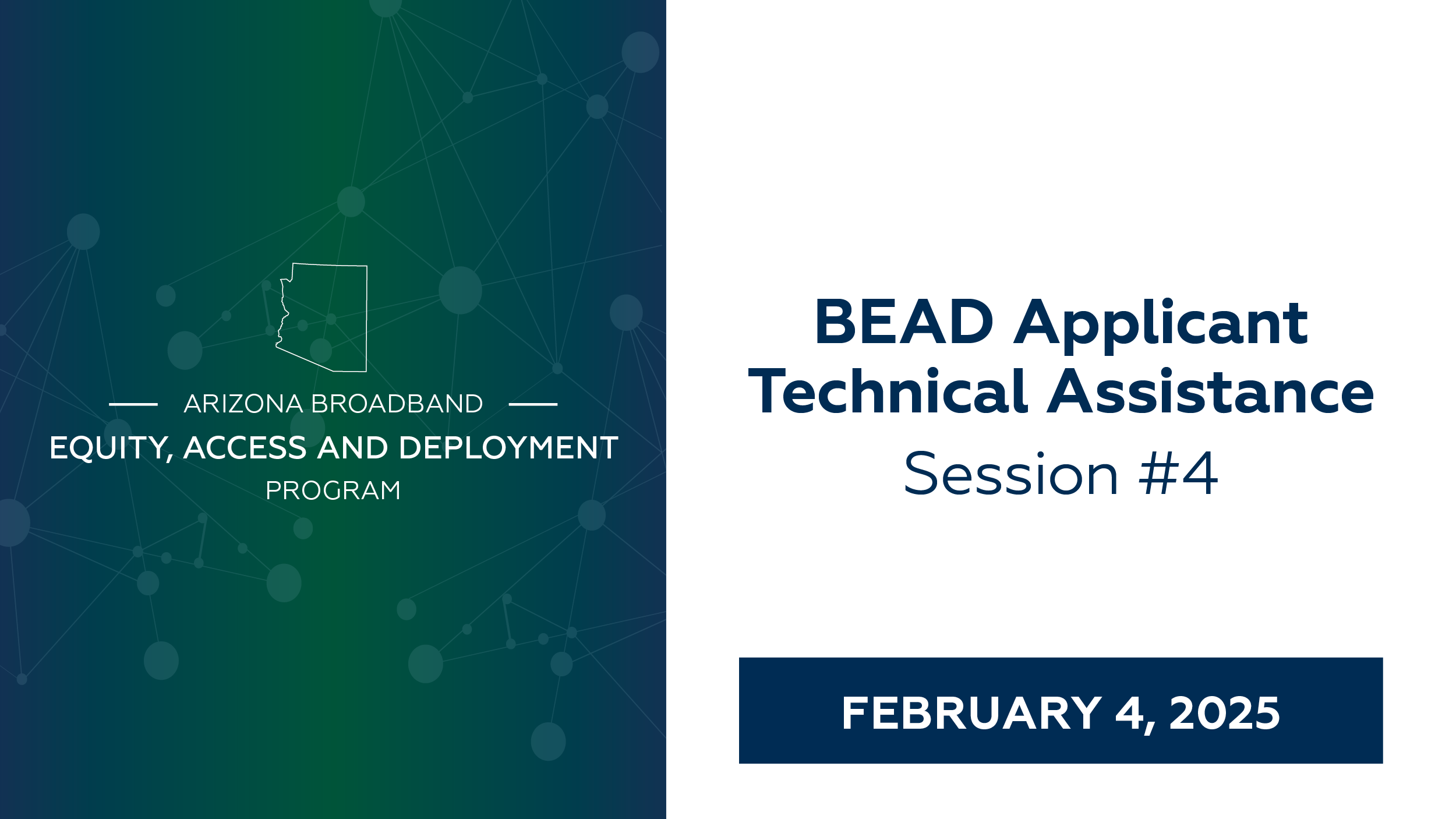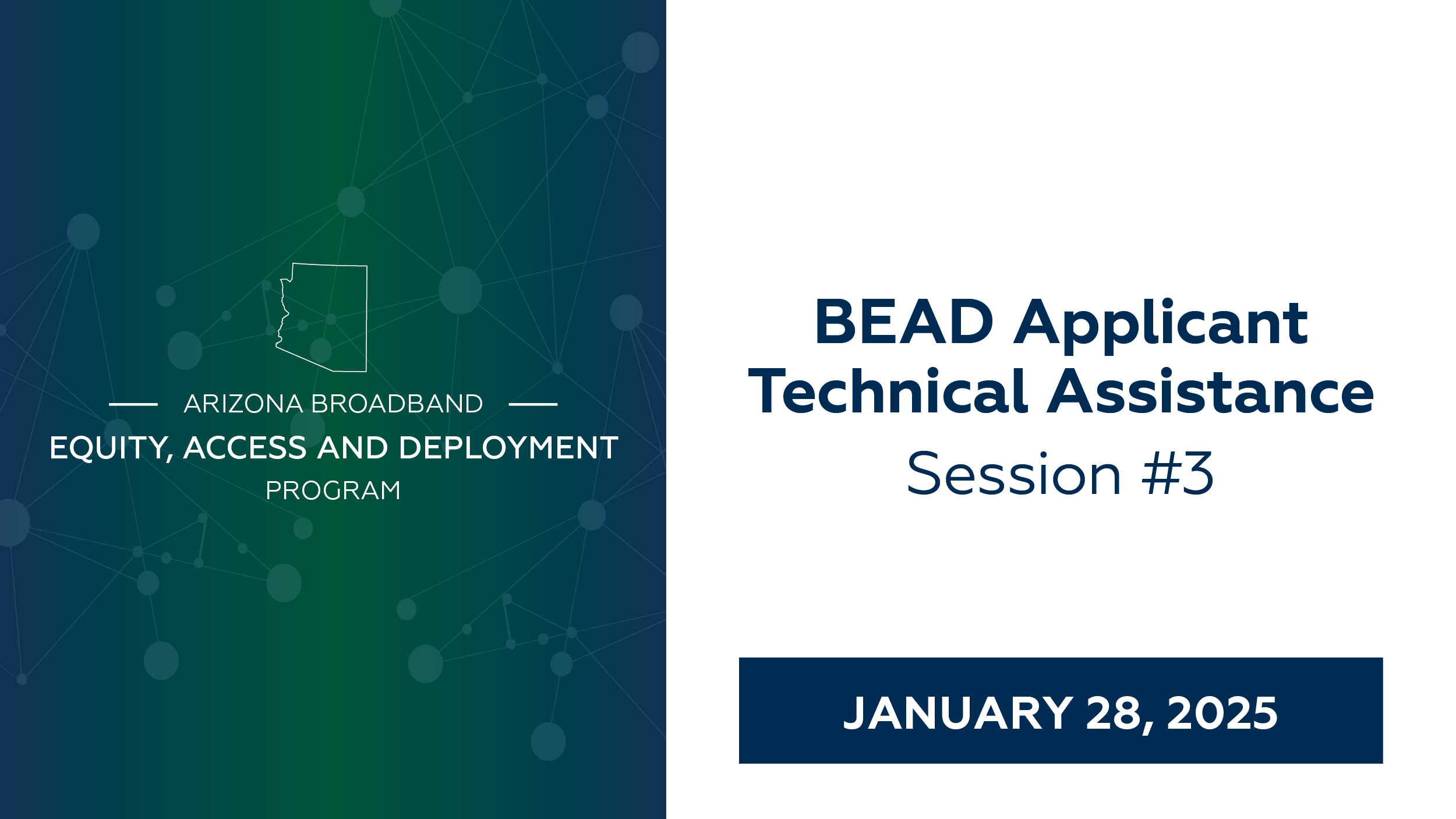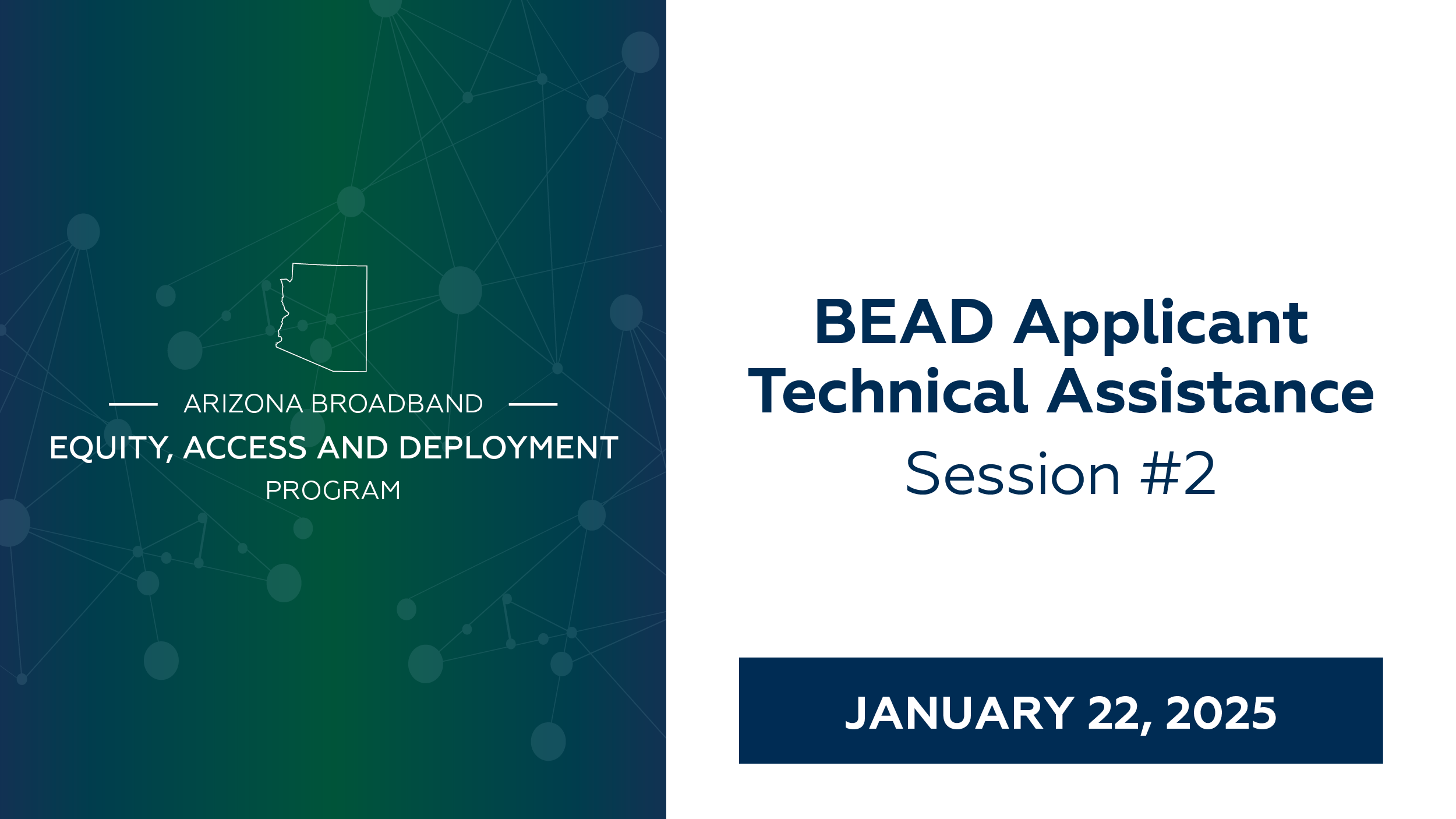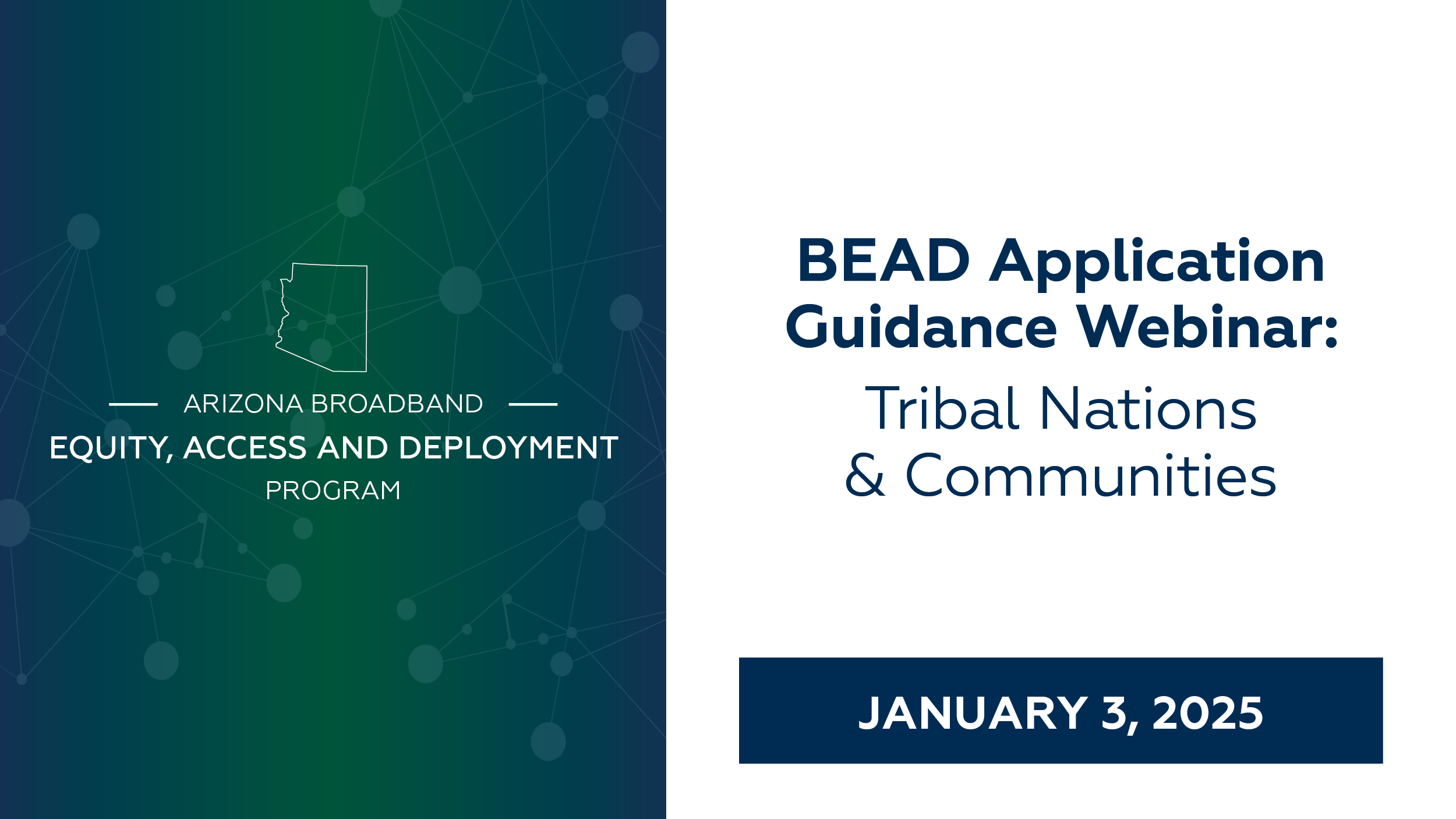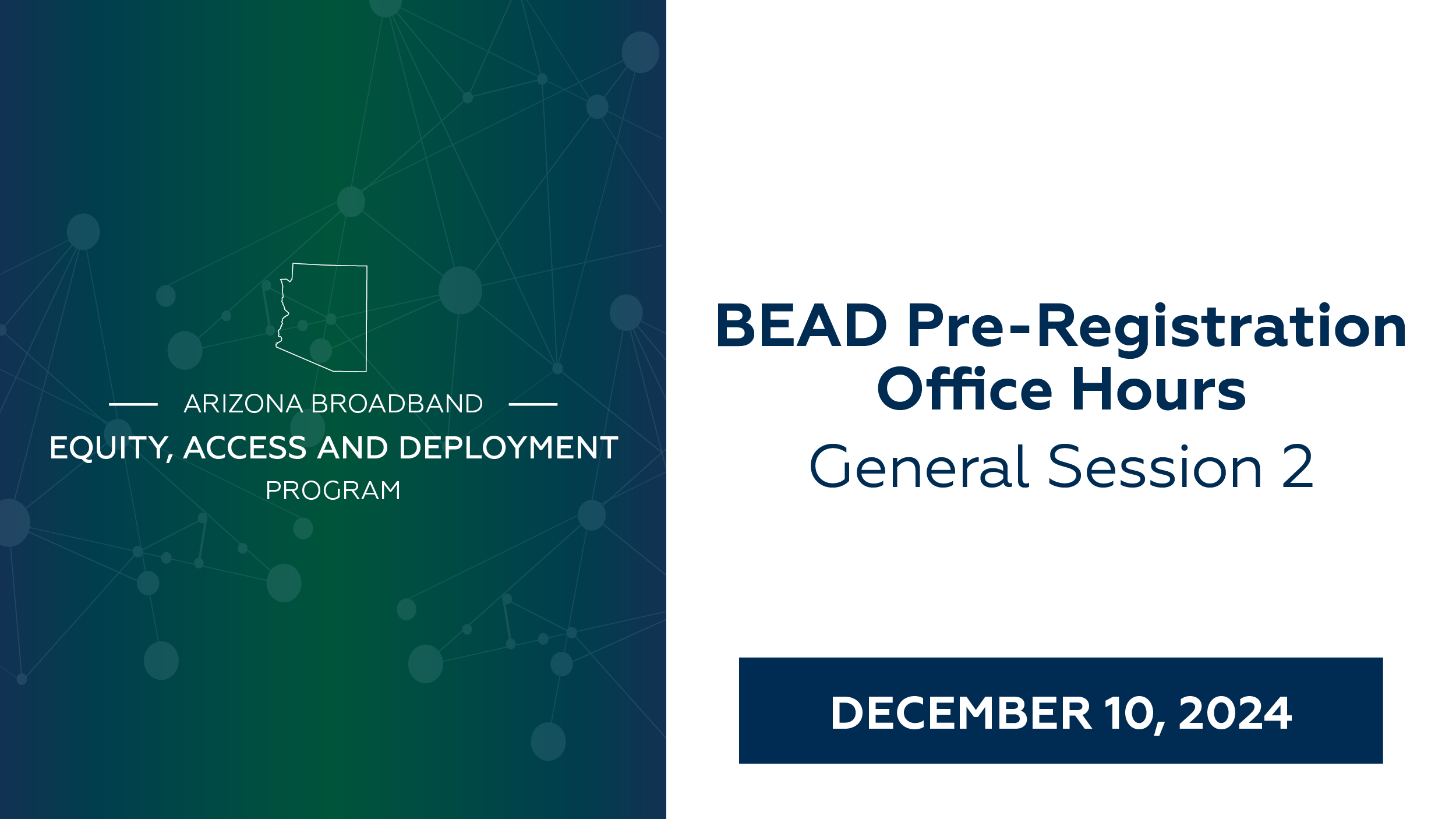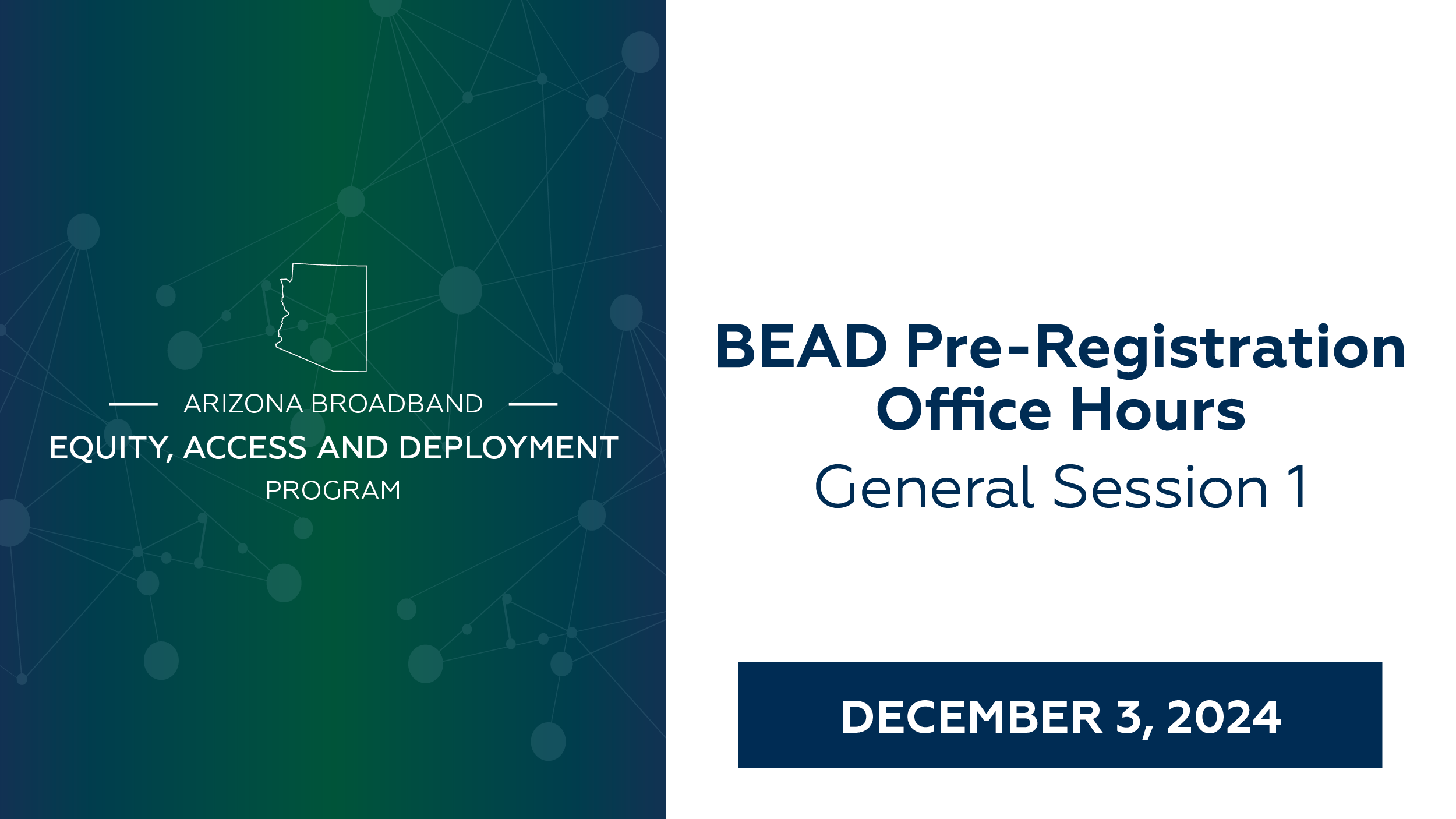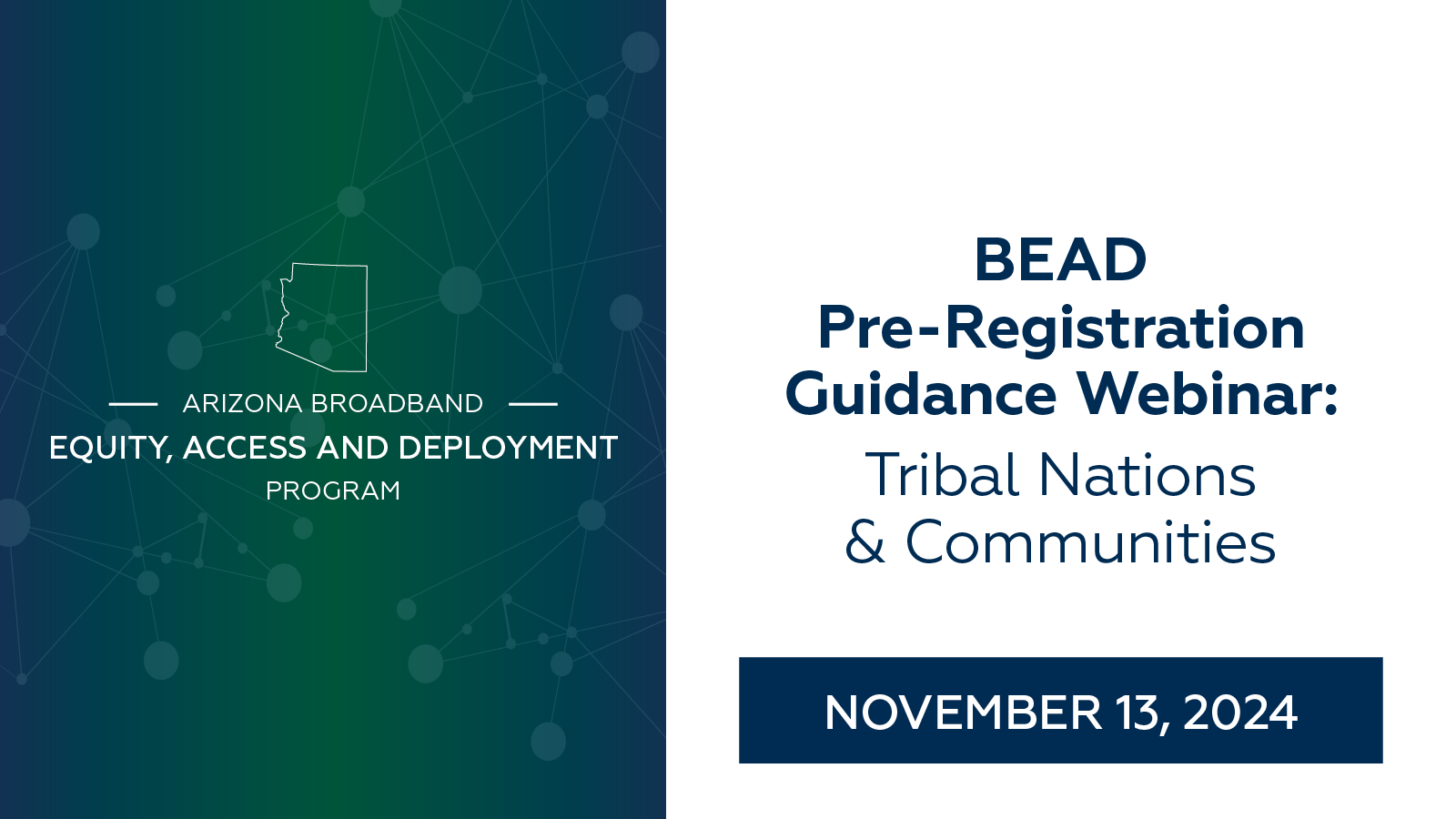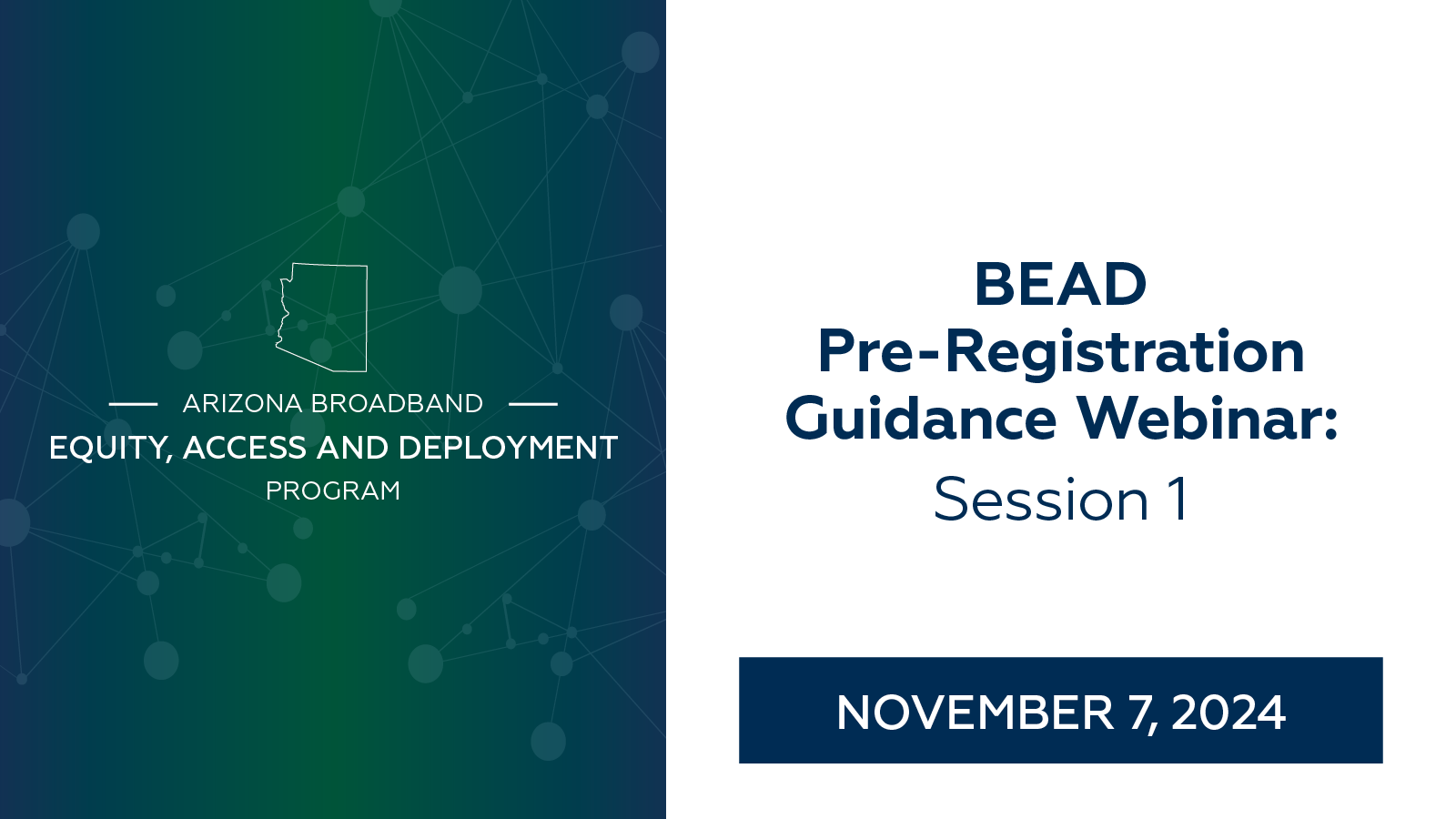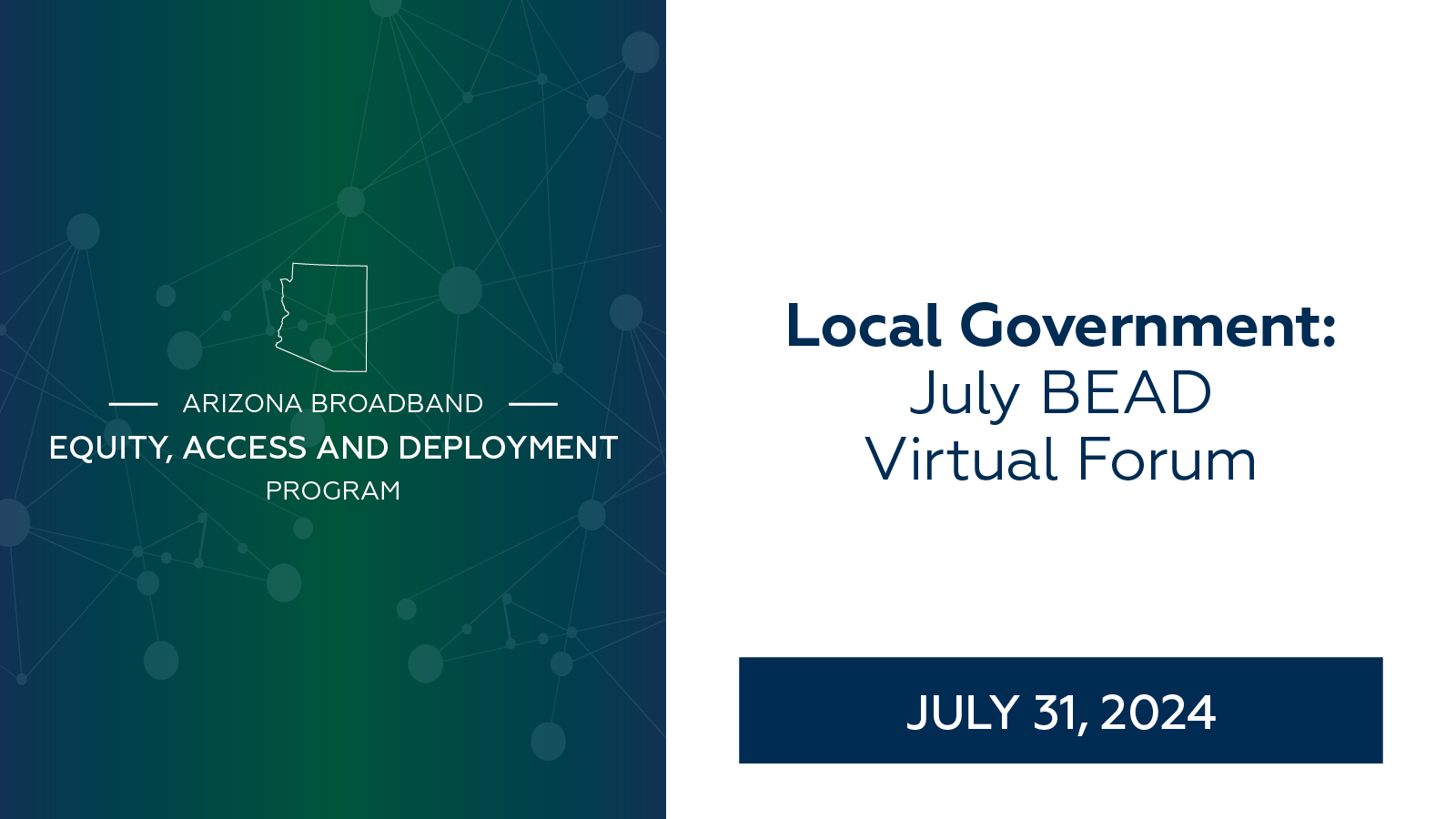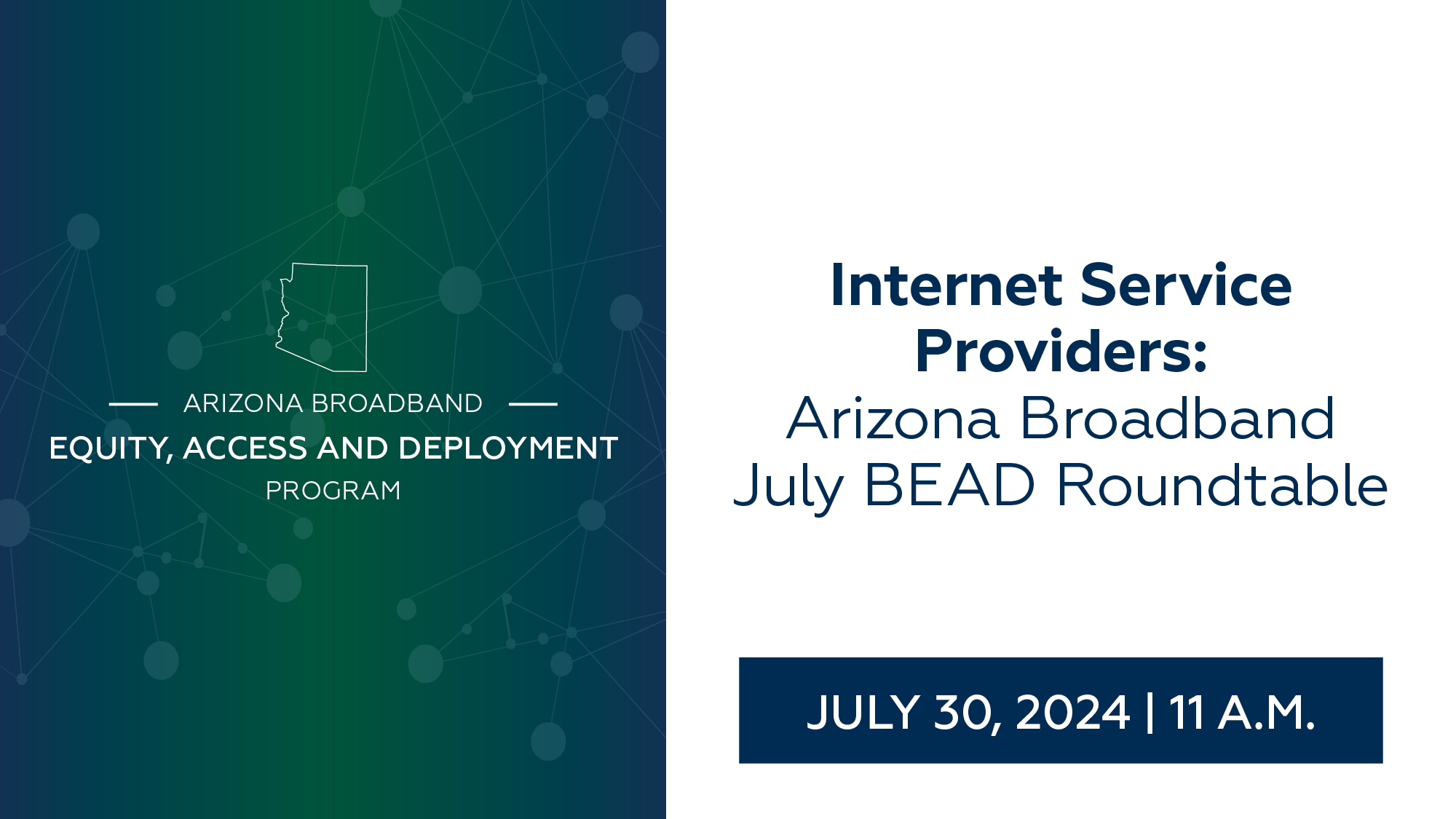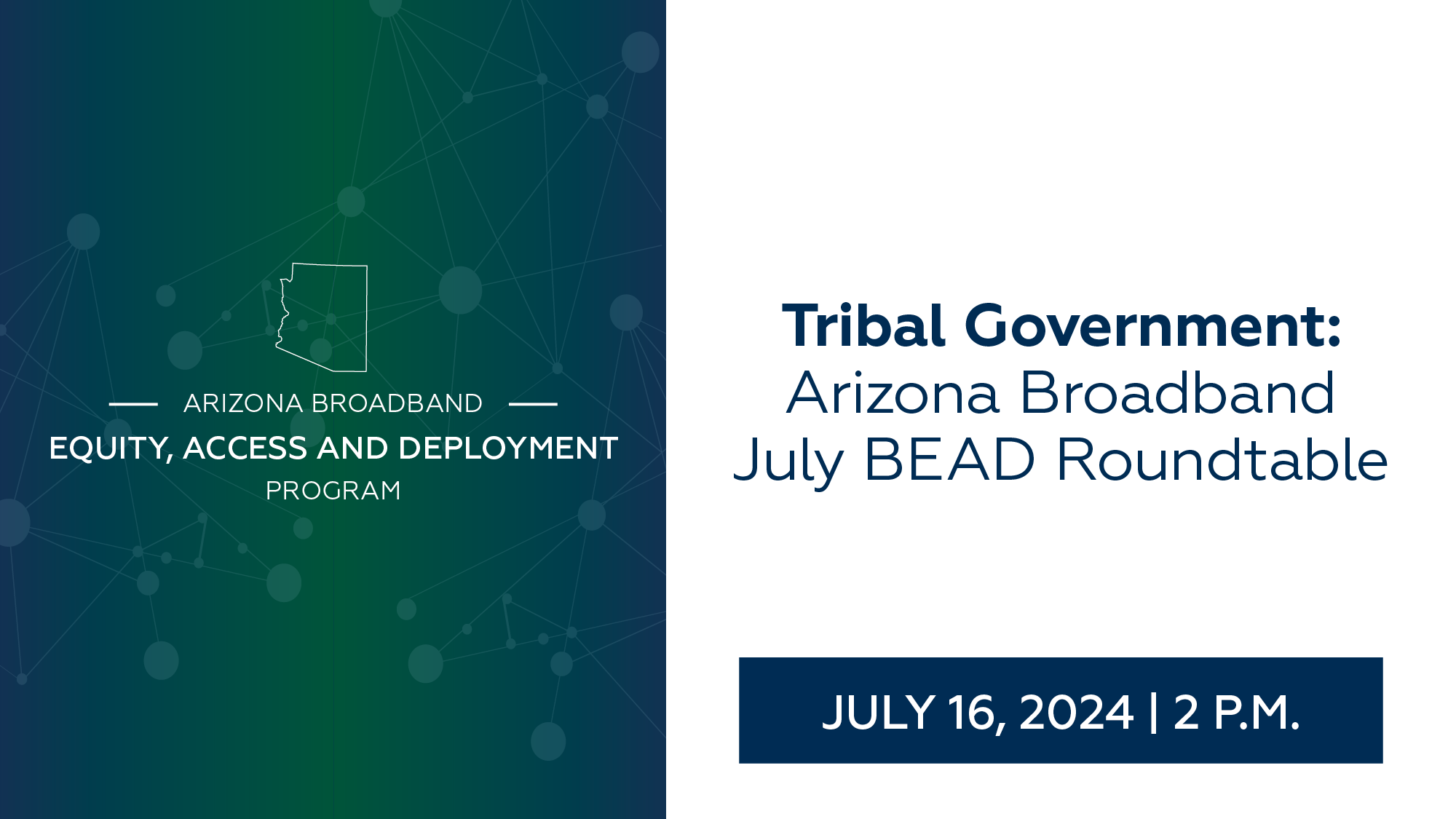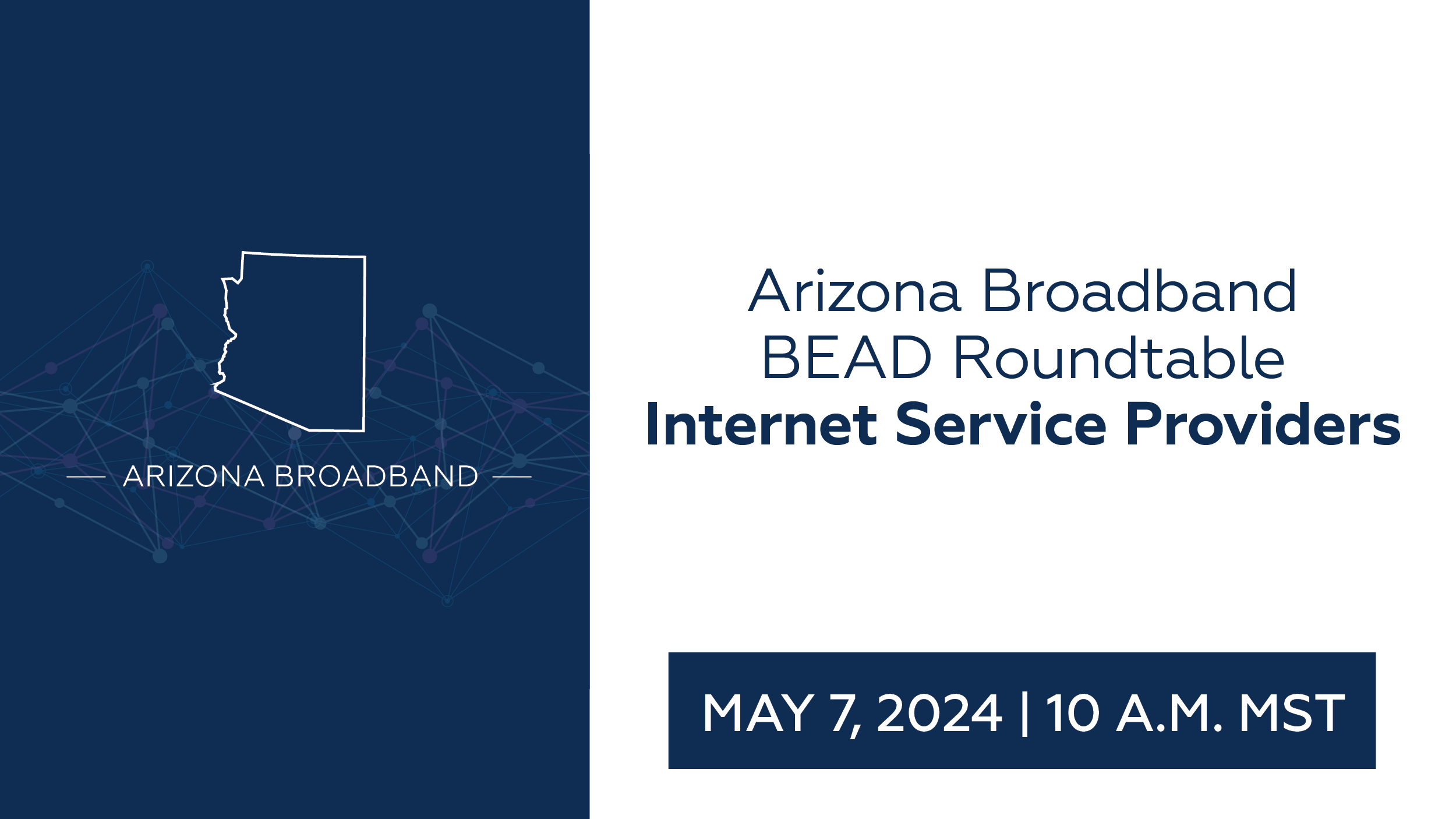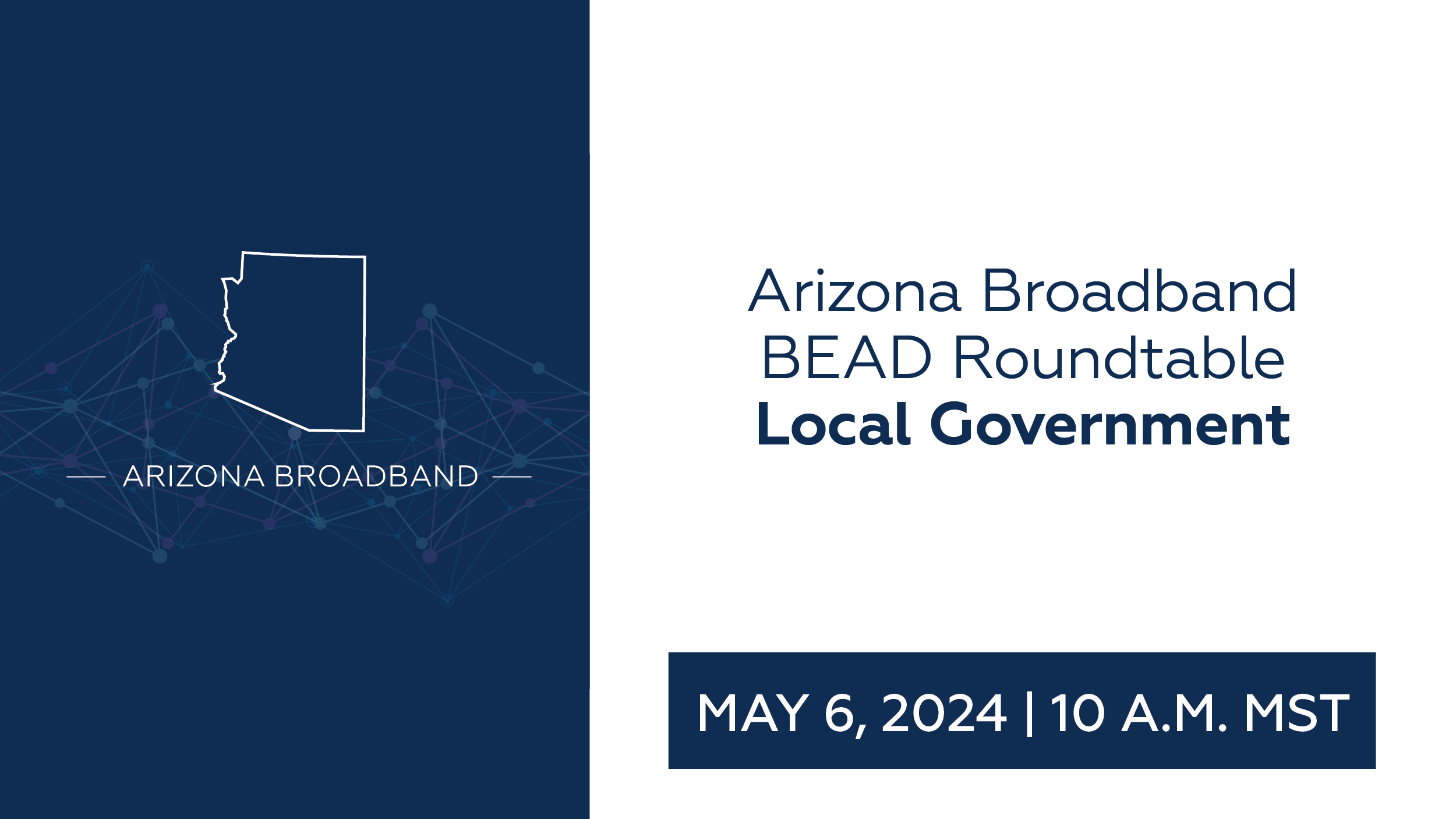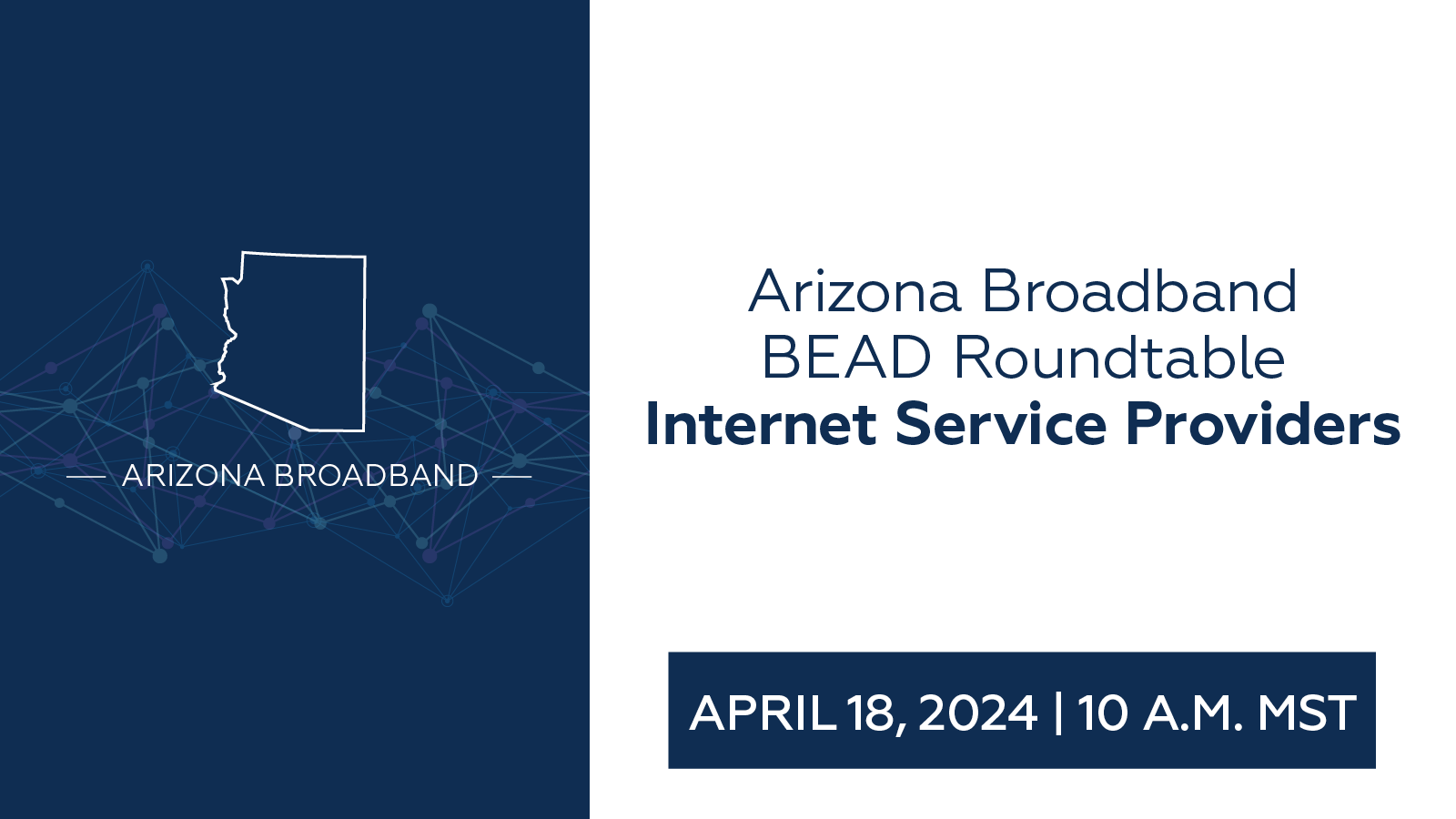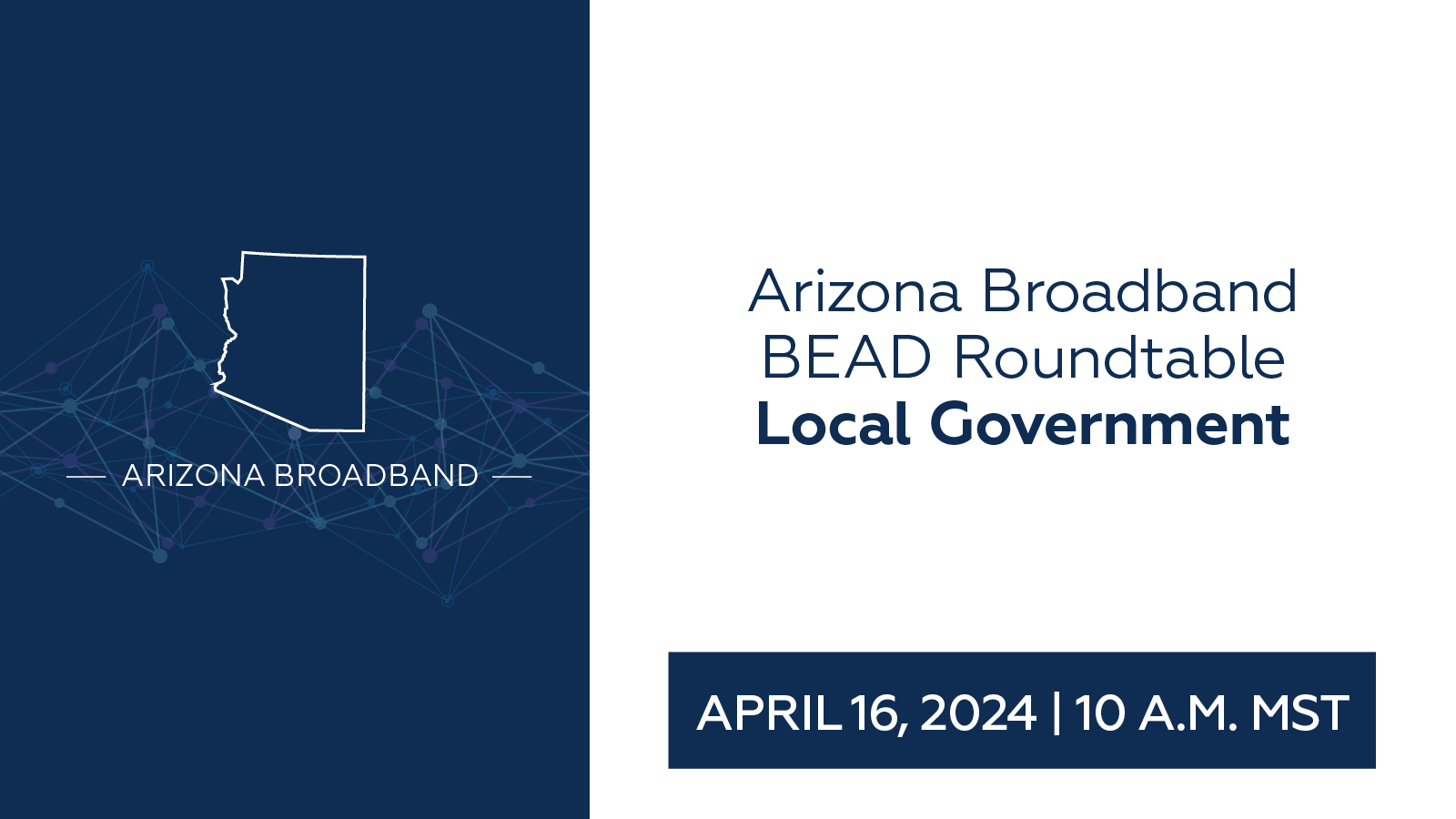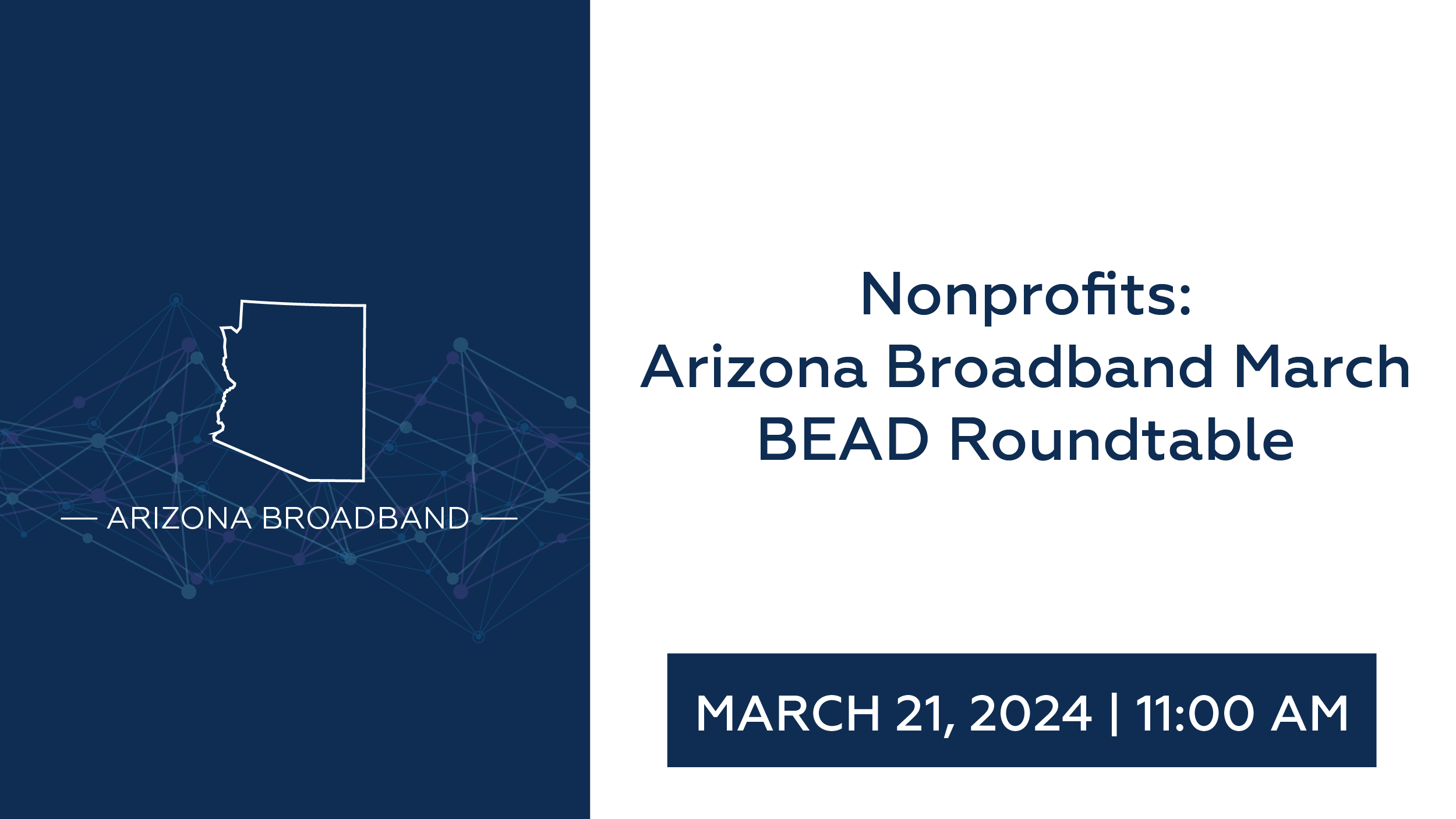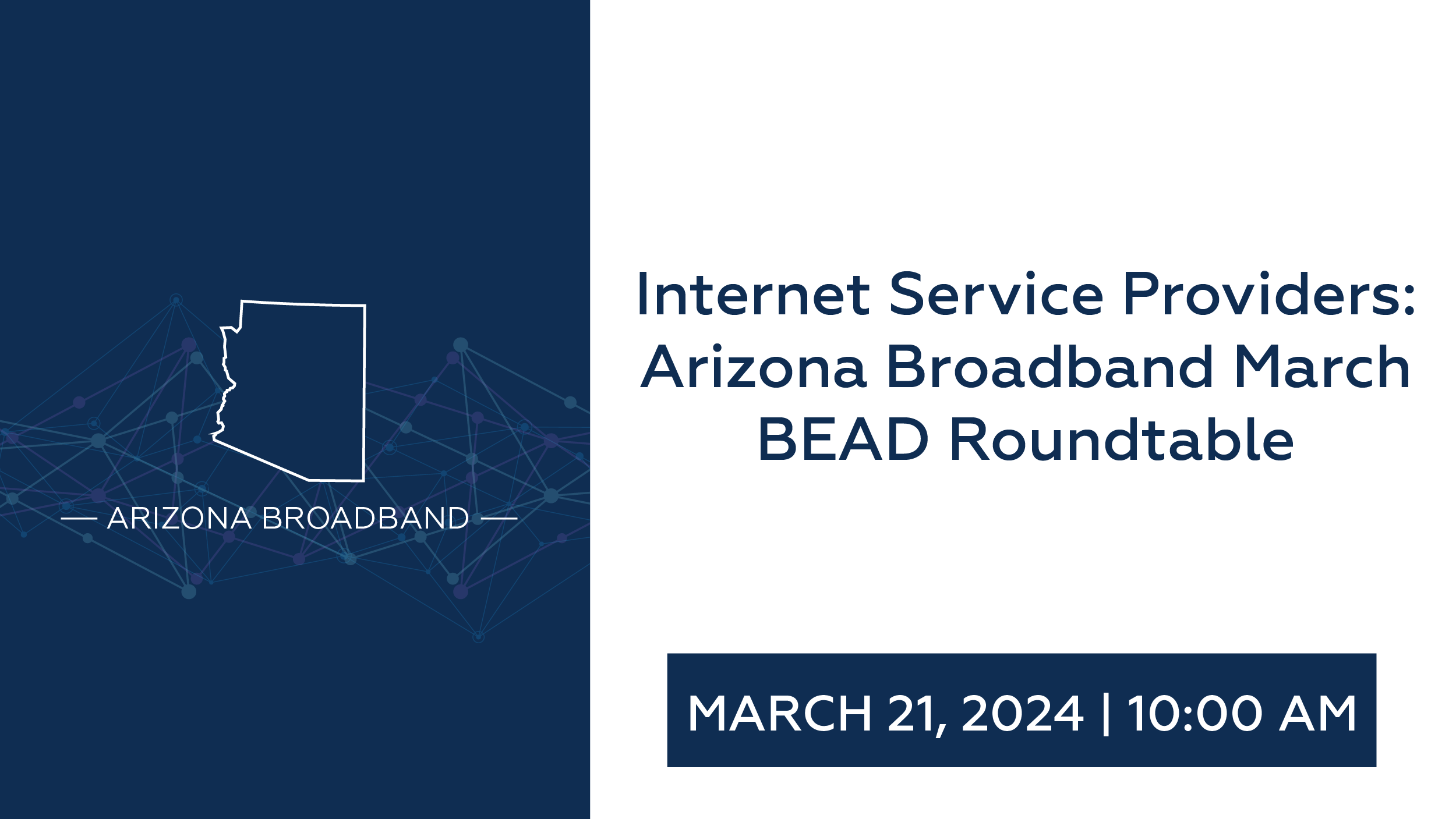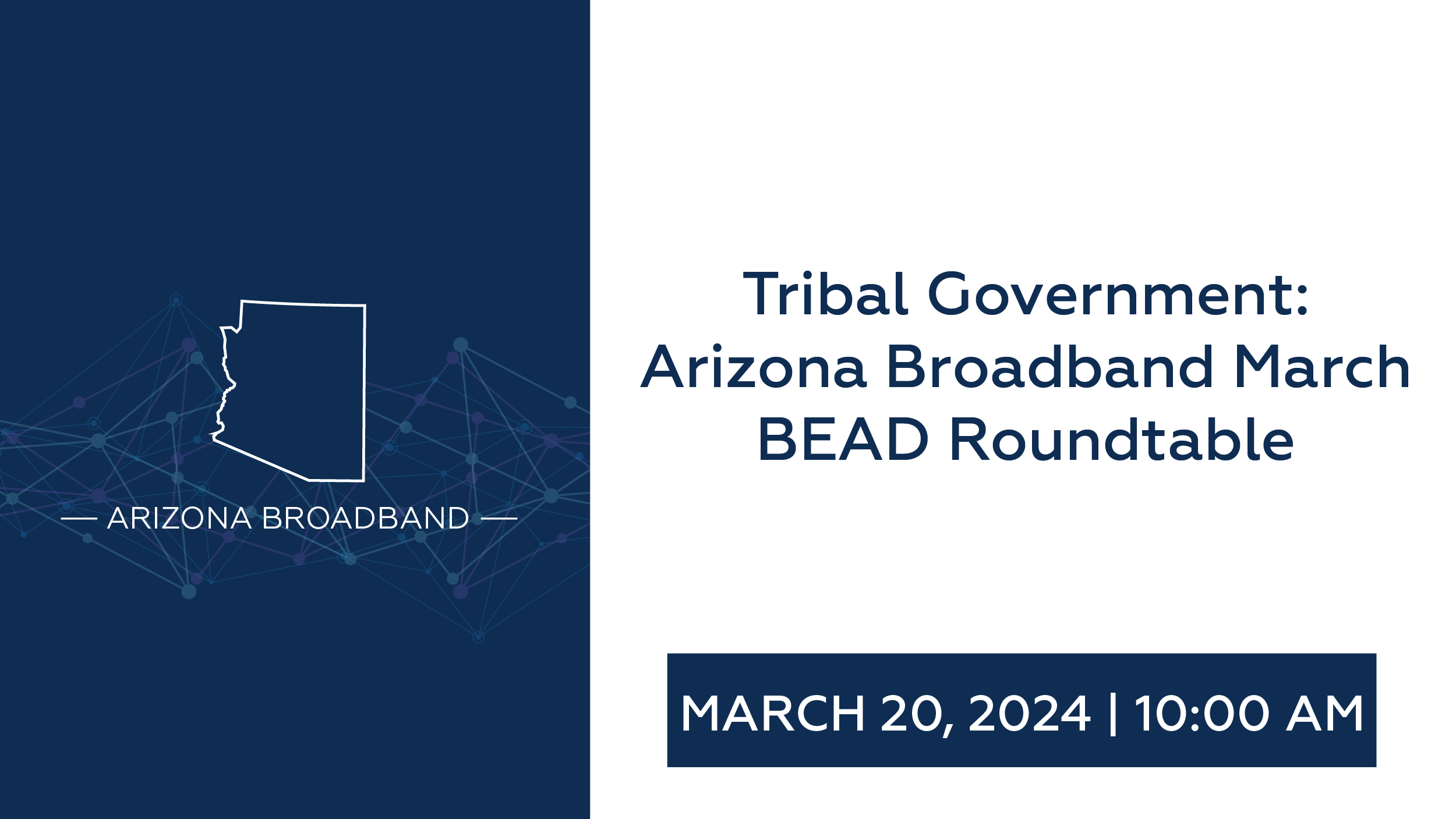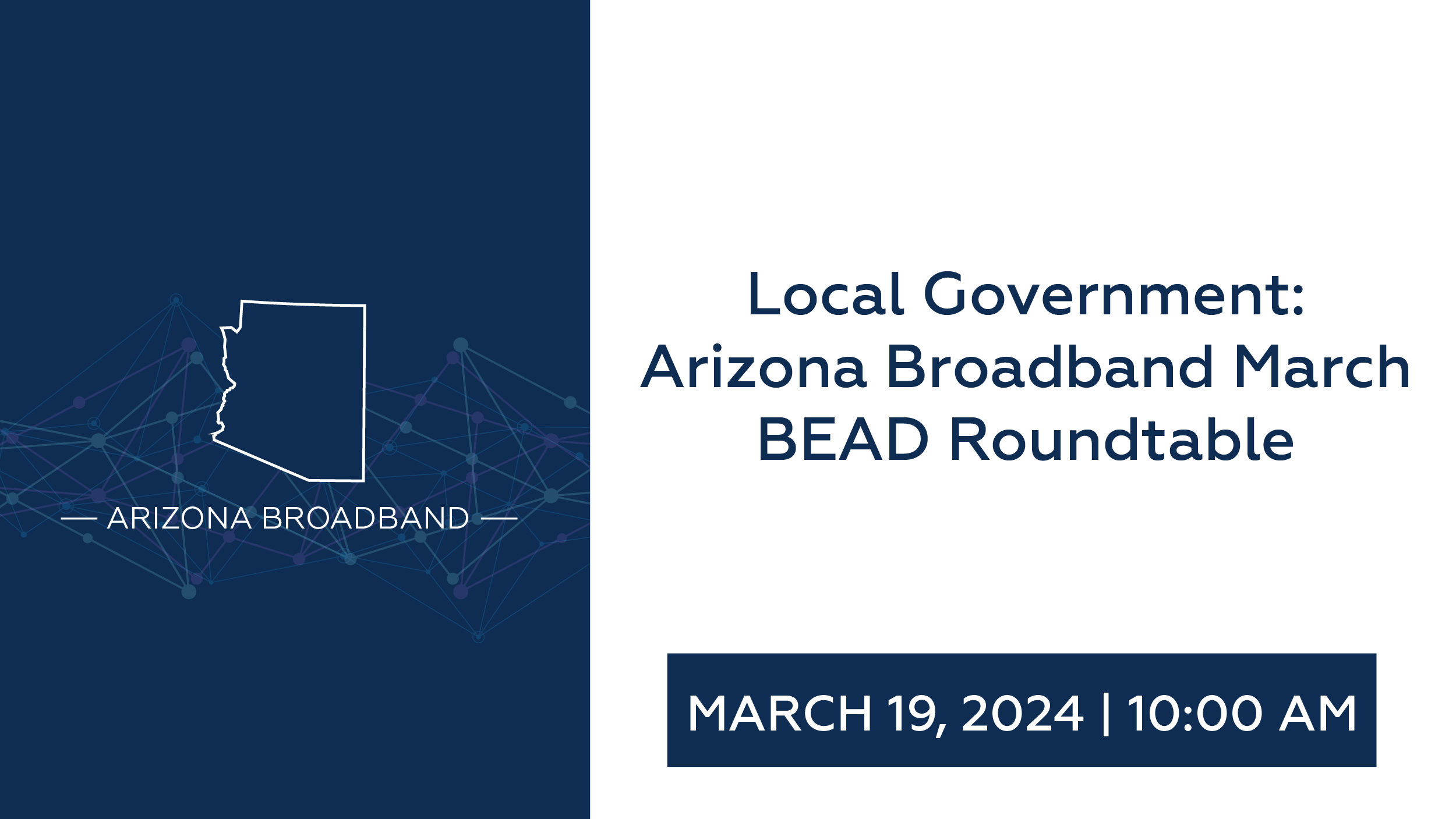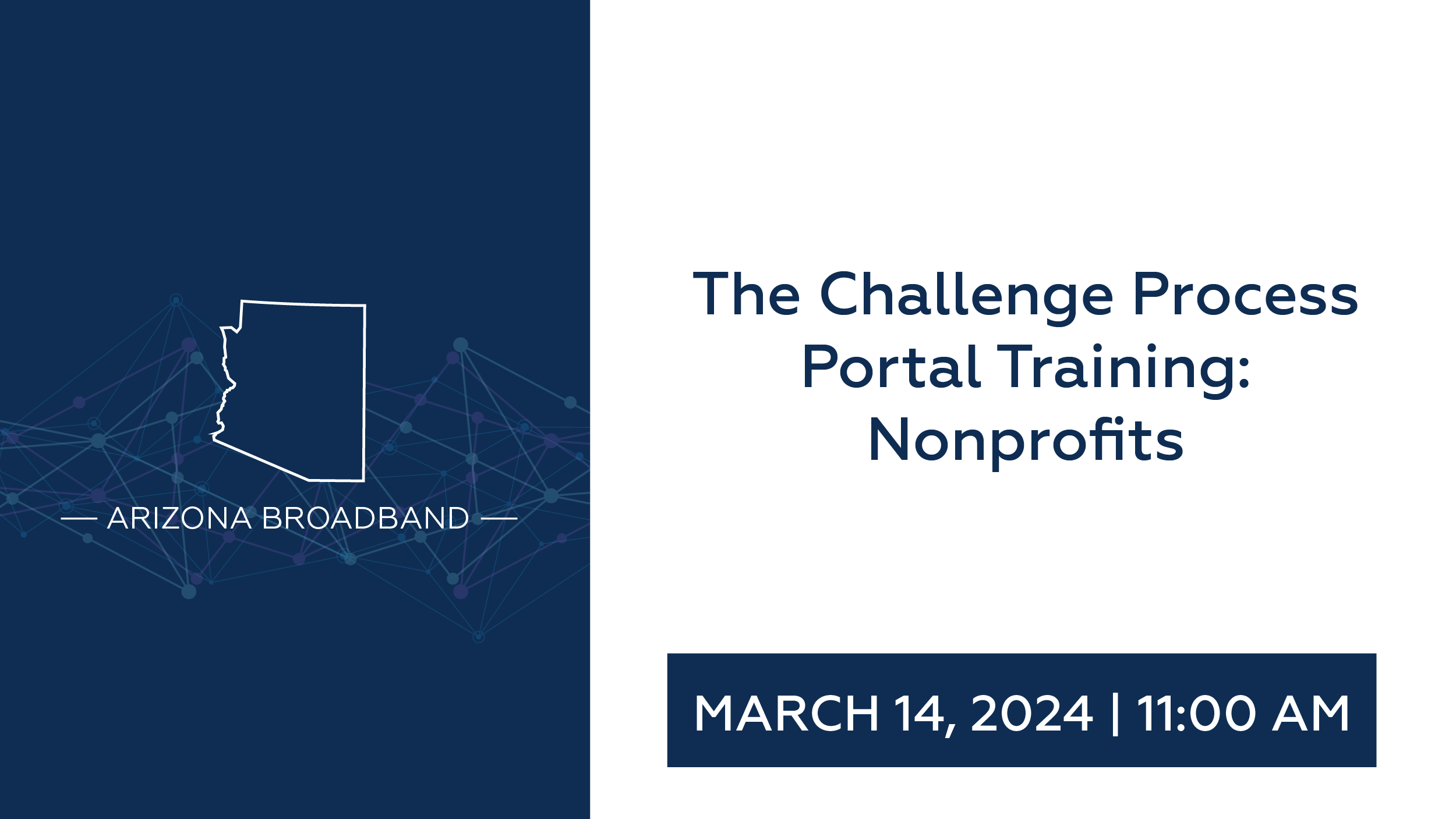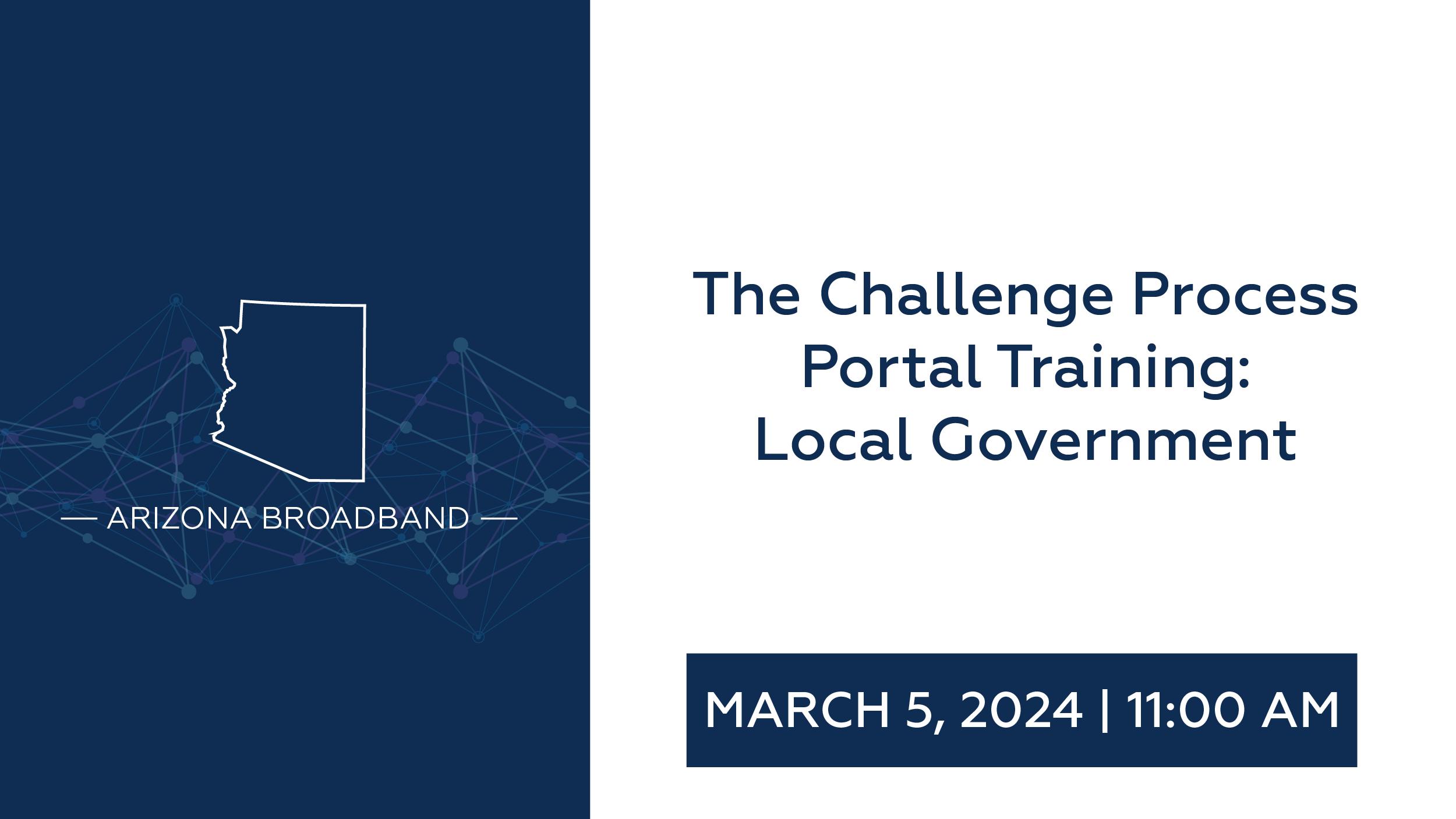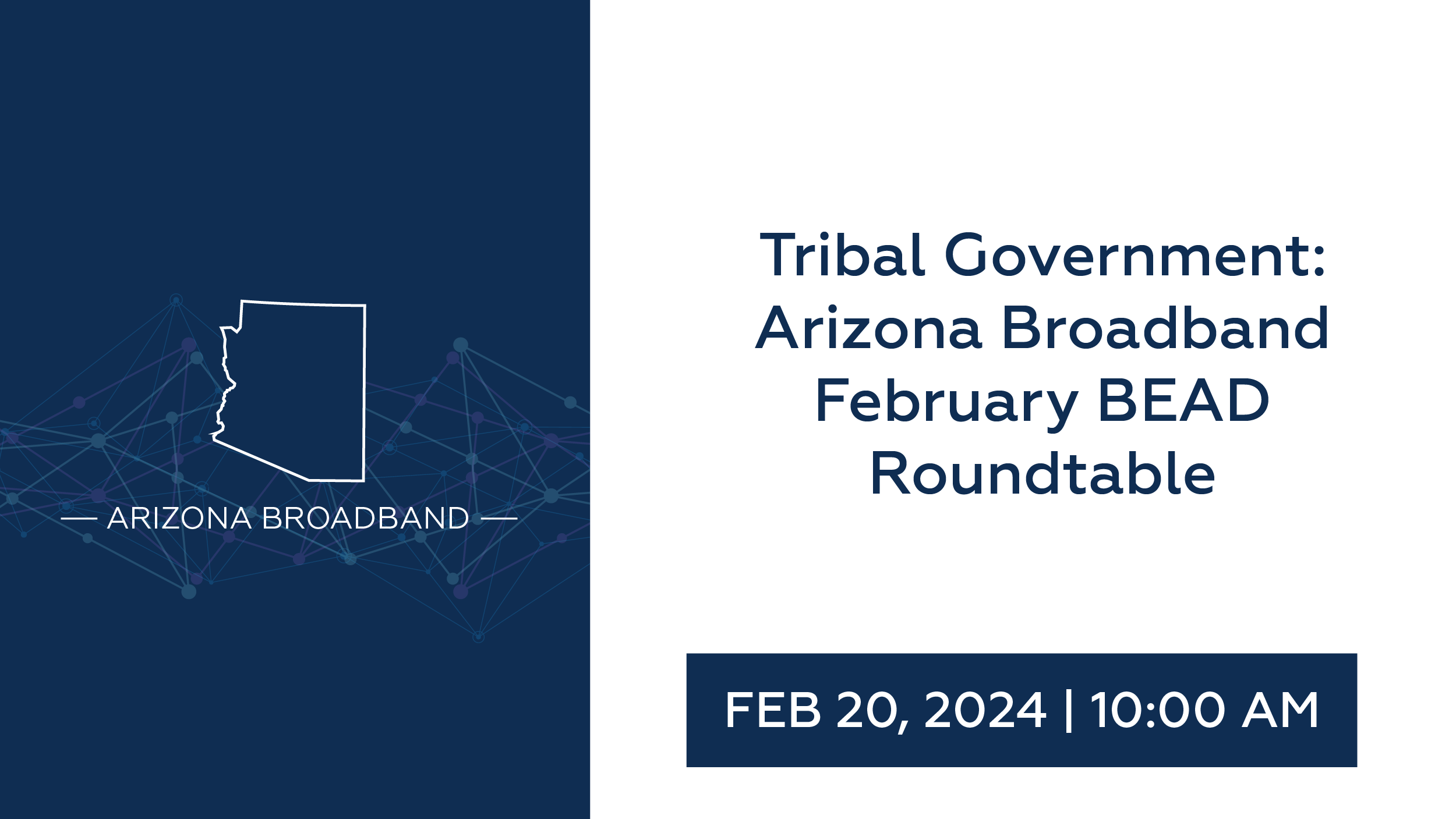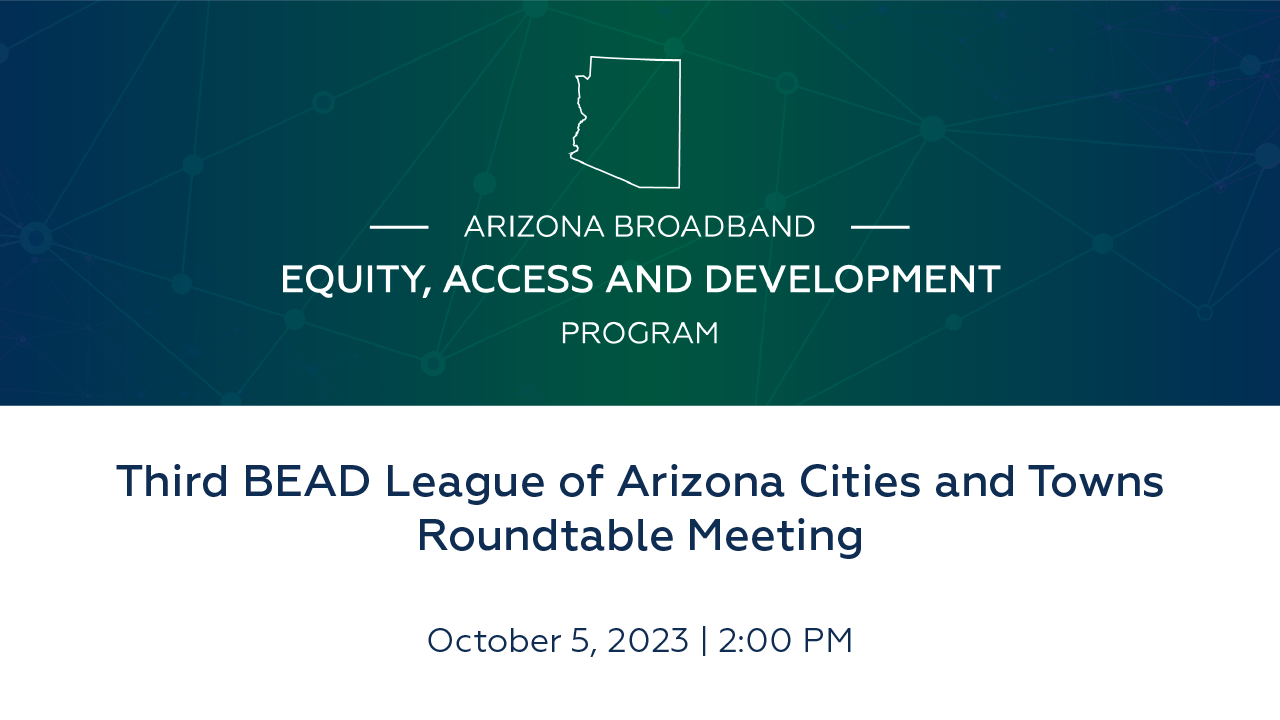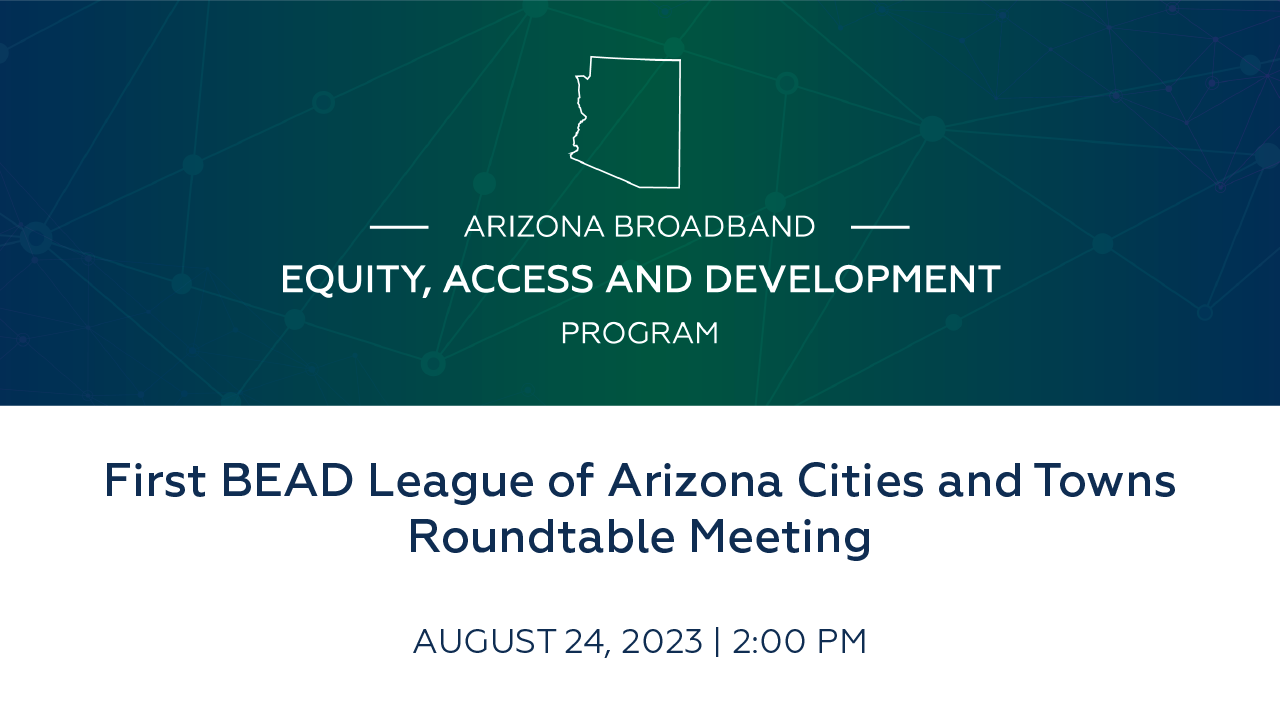
Broadband Equity, Access & Deployment Program (BEAD)
Arizona’s Broadband Equity, Access & Deployment (BEAD) Program represents the state’s largest broadband investment in history with the principal objective of universal broadband for all. BEAD prioritizes unserved and underserved households to improve connectivity, support economic growth, enhance education and improve health care access throughout Arizona.
BEAD Final Proposal
In accordance with the BEAD Restructuring Policy released by the National Telecommunications and Information Administration (NTIA), the State Broadband Office conducted the Benefit of the Bargain Round which closed on July 22, 2025.
Based on the Benefit of the Bargain Round, the State Broadband Office drafted the BEAD Final Proposal for public comment. The public comment period, which was open from Wednesday, August 27, 2025 to Wednesday, September 3, 2025, has officially closed. Feedback submissions have been reviewed carefully and the Final Proposal draft remains available for review.
On September 4, 2025, the State Broadband Office submitted Arizona's BEAD Final Proposal to NTIA and are awaiting feedback. Please check back for updates.
Arizona Broadband Maps
Arizona Broadband Navigator
The Arizona Broadband Navigator Map now includes results from the Benefit of the Bargain Round submitted in our draft Final Proposal. This interactive map shows provisional award information for locations eligible for connection through the BEAD Program.
Arizona Permit Finder
The Arizona Permit Finder Map identifies which permits are required and the agencies that administer them, consolidates permitting requirements into a single, easy-to-use resource, streamlining broadband expansion through a more efficient process.
Arizona State Broadband Map
The Arizona State Broadband Map is used to identify unserved and underserved areas, providing a view of infrastructure needs across Arizona. This map supports state, local, and federal initiatives by visually representing connectivity gaps and progress.
Exhibits
Exhibits subject to change based on NTIA feedback, guidelines and requirements. All data and materials pending NTIA approval.
- Exhibit 01 FP Subgrantees CSV (09152025)
- Exhibit 02 FP Deployment Projects CSV (09152025)
- Exhibit 03 FP Locations CSV (09152025)
- Exhibit 04 FP CAIs CSV (09152025)
- Exhibit 05 No BEAD Locations CSV (09152025)
- Exhibit 06 BEAD ACA Compliance and Monitoring Guidelines
- Exhibit 07 BEAD ACA Reporting Guidelines
- Exhibit 08 ACA Proposed BEAD Subgrant Agreement
- Exhibit 09 ACA BEAD Clawback Procedure
- Exhibit 10 ACA BEAD Program - Requirement 14
BEAD Benefit of the Bargain Round
In accordance with the BEAD Restructuring Policy released by the National Telecommunications and Information Administration (NTIA) on Friday, June 6, 2025, the State Broadband Office launched a new single-round BEAD application process called the "Benefit of the Bargain Round."
The Benefit of the Bargain Round is CLOSED.
All eligible entities, including previous preliminary awardees, are invited to apply. To comply with new NTIA guidelines, the State Broadband Office must rescind all preliminary BEAD awards from the Round 1 Application window.
Approved, pre-registered applicants are eligible to apply through the BEAD Grantor Portal.
BEAD Benefit of the Bargain Round Resources
ACA's BEAD Benefit of the Bargain Round Support Materials
- ACA BEAD Benefit of the Bargain Round Application Evaluation Criteria & Scoring Rubric (7/08/2025)
- ACA BEAD Benefit of the Bargain Round Application Guide (7/11/2025)
- ACA BEAD Benefit of the Bargain Round Application Guidance Summary Deck (7/02/25)
- ACA BEAD Benefit of the Bargain Round Application Questionnaire (7/11/2025)
- ACA BEAD Benefit of the Bargain Round FAQs (7/08/2025)
- ACA BEAD Restructuring Policy Webinar Deck (6/27/2025)
- ACA BEAD Restructuring Policy Webinar Deck (6/13/2025)
ACA's BEAD Benefit of the Bargain Round Application Templates
- ACA BEAD Subgrant Agreement DRAFT (07/31/2025)
- ACA Attachment 1 Project Executive Summary Template (updated 7/07/2025)
- ACA Attachment 5 Project Schedule Template
- ACA Attachment 9 Project Financials Workbook Template (updated 7/07/2025)
ACA's BEAD Benefit of the Bargain Round Maps
- Arizona Broadband Navigator (Updated 7/01/2025)
- Benefit of the Bargain (BOTB) Round eligible locations following ULFW process and CAI modifications:
- ACA Arizona Broadband Navigator Location Data Dictionary (7/07/2025)
- ACA BOTB Round Eligible Locations and CAIs Data Dictionary (7/07/2025)
NTIA Benefit of the Bargain Round Support Materials
BEAD Tribal Consent
For projects on Tribal Lands, the State Broadband Office must reference the NTIA Tribal Map Package as per NTIA’s BEAD Final Proposal Guidance 2025 – Requirement 15. This package includes data from the Bureau of Indian Affairs (BIA). If there are discrepancies between the map package and information from Tribes, the State Broadband Office must obtain a letter from the Tribe clarifying the locations.
The State Broadband Office has found some discrepancies on Tribal Lands compared to the NTIA’s Tribal Map package. We are working to resolve these discrepancies and welcome input from Tribes to ensure accurate information regarding BEAD eligible locations on Tribal Lands.
Pre-Approved Applicants
The following applicants have been approved through BEAD Pre-Registration and are eligible to apply during the Benefit of the Bargain Round.
BEAD Pre-Registration - Closed
Pre-registration closed June 30, 2025. Pre-registration is a required step to apply for BEAD funding in Arizona.
BEAD Restructuring: Reason Code 5
The Arizona Commerce Authority (ACA) is inviting all Internet Service Providers (ISPs) operating within the state to submit their evidence in support of the Reason Code 5 locations that may already be "Served by Non-Subsidized Service," defined by the NTIA.
In accordance with BEAD program requirements, including the most recent BEAD Final Proposal Guidance (Unserved and Underserved Locations, Requirement 7, page 32) and BEAD Restructuring Policy Notice (Optimizing BEAD Locations, section 4, page 13), ACA will review and evaluate evidence and support documentation submitted by participating private network providers to ensure that locations identified as potentially ineligible for BEAD funding based on Reason Code 5 deliver "Reliable Broadband Service," defined as at least 100 Mbps download and 20 Mbps upload speeds, with latency not exceeding 100 milliseconds.
The appropriate application of Reason Code 5 is essential in directing BEAD program funds where they are most needed, preventing redundancy in areas already served by existing non-subsidized broadband services. It is also critical to ensure qualifying evidence supports the conclusion that these locations have access to Reliable Broadband Service to prevent unserved or underserved locations from being excluded from funding eligibility. This targeted approach ensures that broadband deployment efforts and investments are focused on regions of Arizona that are either unserved or underserved in terms of reliable high-speed internet access across the state.
For this purpose, ACA has made the following information available:
- BEAD Challenge Technology Information Workbook(s)
The Reason Code 5 evidence submission process will initiate on Wednesday, July 23, 2025, at 12:00 pm MST and end on Monday, July 28, 2025, at 12:00 pm MST. All Reason Code 5 evidence submissions are required to be submitted through the Arizona Broadband Navigator portal. Evidence MUST be submitted in the format outlined above to be considered.
For further information, please contact the ACA State Broadband Office at [email protected].
BEAD Restructuring: ULFW and BEAD Location Eligibility
Unlicensed Fixed Wireless providers (ULFW) in Arizona are hereby informed they have seven calendar days from the date of this notice (June 13, 2025) to indicate they intend to submit supporting evidence that BEAD funding is not required for the locations they serve. This is in accordance with significant federal amendments to the BEAD program outlined in the BEAD Restructuring Policy Notice published June 6, 2025 (see Section 4: Optimizing BEAD Locations and Appendix A).
To facilitate this process, a list of service locations that qualify for the BEAD program funding and are shown as served in the latest BDC version is available here.
ISPs intending to submit their supporting evidence demonstrating BEAD funding is unnecessary for the locations they serve are required to send an e-mail notification by 5:00pm MST on Friday, June 20, 2025, to [email protected]
The ACA will provide further guidance to ULFW providers who sent email notification of their intent to submit by the specified deadline above (5:00pm MST on Friday, June 20, 2025).
----------------
Only ULFW providers that responded to the State Broadband Office's original notice by the June 20, 2025, 5:00pm MST deadline are eligible to participate. Providers have seven calendar days from June 20, 2025 to provide the required documentation supporting the claim that existing ULFW services meet the technical and service standards necessary for a BEAD subgrant.
For additional information, please refer to Appendix A of the Restructuring BEAD Policy Notice for specifics on these standards. Successfully demonstrating compliance will render the served locations ineligible for BEAD program funding.
All supporting documentation from eligible ULFW providers must be submitted to Arizona Broadband Navigator portal by 5:00 pm MST on Friday, June 27, 2025.
Pre-Restructuring Policy Archives
The information below this section is for archival purposes only. Resource documents will be updated in accordance with the NTIA's Restructuring Policy. Check back for updated resources soon.
BEAD Round 2 Project Areas Map (Archive)
The BEAD Round 2 Project Areas map shows locations open for bid in Round 2 of the BEAD Subgrantee Application process. The map provides a high-level view of the project areas preliminarily selected in Round 1 and shows the areas and locations available for Round 2.
The map is designed to keep stakeholders informed and aware of the progress made and the areas that need service.
Round 2 Application Resources - Archived
- Application Guidance (updated 6/02/2025)
- Application Questionnaire (updated 6/02/2025)
- Application Guidance Webinar Deck (updated 6/02/2025)
- Application FAQs (updated 6/2/2025)
- Project Cost Scoring Clarification
- Draft Subgrantee Agreement
- Attachment 8A Part A1 Project Financials Workbook Template
- Attachment 8A Part A2 Project Financials Workbook Template
- Attachment 8B Project Financials Workbook Template
Round 1 Application Resources - Archived
- Application FAQs (updated 4/07/2025)
- Application Guide (updated 2/13/2025)
- Application Questionnaire
- Application Checklist
- Application Guidance Webinar Deck (February 2025)
- Application Guidance Webinar Recording (January 2025)
- Technology Solutions Clarification
- Project Cost Scoring Clarification
- Draft Subgrantee Agreement
- NOTE: A new Subgrantee Agreement coming for Benefit of the Bargain Round
- Attachment 8A - Part A1**
- Attachment 8A - Part A2**
**These templates replace the original Round 1 templates. New templates were created in response to feedback from BEAD Applicants. Templates were uploaded and provided 02/25/2025 to applicants via email, on the website and in the BEAD Grantor Portal.
Final BEAD Project Areas
The State Broadband Office conducted the BEAD Project Area Market Sounding exercise from September 23, 2024 to November 7, 2024. During this period, feedback was collected on draft project areas from all Stakeholders. The State Broadband Office thoroughly reviewed all feedback and adjusted some of the draft project areas to ensure that all BEAD-eligible locations are served.
Additional files are also available for download that include project area PDFs and Final Project Area Polygon files:
The BEAD Market Sounding Exercise
Arizona was awarded $993.1 million in federal funding to build infrastructure and expand internet access in rural and historically underserved communities. BEAD funds will be prioritized in the following order:
- Connect unserved locations (available service is 25/3 Mpbs per second or less)
- Connect underserved locations (available service is at least 25/3 Mpbs but less than 100/20 Mbps)
- Connect Community Anchor Institutions (CAIs) to gigabit symmetrical service (1,000/1,000 Mpbs)
The BEAD Marketing Sounding Exercise, which will run for 45 calendar days from 9/23/2024 to 11/7/2024, was designed is to solicit feedback on the Initial Project Area draft for the BEAD Program, ensuring it aligns with the connectivity needs of all Arizona communities. Through gathering input, the State Broadband Office seeks to make any necessary adjustments to better serve the goal of improving internet access across the state.
The BEAD Market Sounding Exercise is not a requirement of NTIA, but a commitment by the State Broadband Office to continually ensure transparency and feedback loops throughout the BEAD Program.
BEAD Eligible Subgrantees may participate, which includes local governments, nonprofit organizations, tribal nations and communities, and Internet Service Providers (ISPs). These participants are invited to comment on the Initial Project Area Draft as registered users in the
Arizona Broadband Navigator.
BEAD Market Sounding Resources
- Frequently Asked Questions (FAQs)
- Arizona Broadband Navigator User Guide
- Arizona Broadband Navigator
- PENDING Post Challenge CAIs
- PENDING Post Challenge Locations
- Project Area Polygons GeoJSON
- Post-Challenge Data Dictionary
Please note that the ‘pending’ links above are not final. In curing, each data update uses newer FCC maps for true-up and deduplication, which slightly impacts the results. The final list of BEAD-eligible locations will be posted after NTIA approval is received.
BEAD Permitting & Environmental and Historical Preservation (EHP) Support
As a part of the ConnectAllAZ initiative, the Arizona Commerce Authority’s State Broadband Office will support BEAD subgrantees and federal, state and county partners to meet BEAD program requirements. The State Broadband Office is leading implementation of the program by coordinating stakeholders, streamlining processes and providing resources to ensure deployment of broadband infrastructure across Arizona.
Arizona's Permit Finder Map
Arizona’s interactive broadband permitting map, the Permit Finder consolidates federal, state, and local permitting requirements into a single, easy-to-use resource. By simplifying the permitting process, the map ensures projects move forward efficiently and effectively, demonstrating Arizona’s leadership in broadband deployment.
- How to use the Permit Finder one-pager
- How to use the Permit Finder Instructional video
This map reflects Arizona’s commitment to successful BEAD program implementation, offering a proactive solution that streamlines permitting and advances broadband expansion across the state.
Permitting Resources
- State and Federal Programmatic Assessments
- Permitting Strategy and Process Maps
- Progress and Compliance Tracking (coming soon)
- Environmental and Historic Preservation (EHP) Support (coming soon)
- NTIA: What is permitting?
- NTIA: BroadbandUSA Permitting Website
- NTIA: How to Plan and Prepare for NEPA Compliance for BEAD
Additional permitting resources coming soon - check back often for updates.
BEAD Timeline
In accordance with the BEAD Restructuring Policy released by the National Telecommunications and Information Administration (NTIA) on Friday, June 6, 2025, the State Broadband Office launched a new single-round BEAD application process called the "Benefit of the Bargain Round." All eligible entities, including previous preliminary awardees, were invited to apply. To comply with new NTIA guidelines, the State Broadband Office must rescind all preliminary BEAD awards from the Round 1 Application window. Pre-registration is required to participate in the subgrantee application process. Learn more.
Updated Application Timeline
- Tuesday, July 8: Benefit of the Bargain Round Opens at 4:00pm MST
- Tuesday, July 22: Benefit of the Bargain Round Closes at 4:00pm MST
- Wednesday, July 23 to Friday, August 15: ACA Application Review and Evaluations
- Wednesday, August 27: BEAD Final Proposal Public Comment Period Opens
- Wednesday, September 3: BEAD Final Proposal Public Comment Period Closes
- Thursday, September 4: NTIA deadline for SBOs to submit Final Proposals for Approval
In accordance with the BEAD program requirements and NTIA's Restructuring Policy, the State Broadband Office intends to complete its deployment by 2029.
NOTE: This timeline is tentative, pending NTIA approval. This timeline may differ from previous and existing publicly posted information from the ACA.
BEAD Five-Year Action Plan
Arizona Governor Katie Hobbs’ vision is to provide dependable and affordable high-speed internet services to every community and access to the necessary digital skills, so every resident can full participate in a digital world. The Arizona State Broadband Office has developed the BEAD Five-Year Action Plan to serve as a guide to identify and deploy the state's historic broadband investment.
BEAD Five-Year Action Plan Goals
The state is committed to providing universal broadband for all. The BEAD Five-Year Action Plan outlines the following goals under the BEAD Program.
INFRASTRUCTURE INVESTMENTS:
- Align broadband infrastructure with healthcare, education, public safety and economic development.
- Use state and federal programs to ensure 100↓ / 20↑ Mpbs Internet Service.
- Collaborate with universities and colleges to expand broadband.
UNIVERSAL CONNECTIVITY:
- Provide high-speed internet to all households, businesses, institutions and Tribal Nations.
- Identify areas lacking 100↓ / 20↑ Mpbs Internet Service.
- Address barriers to broadband expansion.
- Simplify permitting and right-of-way processes.
- Invest in new broadband infrastructure.
21ST-CENTURY WORKFORCE:
- Create workforce programs focusing on technology and high-wage jobs.
- Partner with educational institutions to prepare students for tech jobs.
- Offer reskill and upskill programs for displaced workers.
AFFORDABLE INTERNET:
- Promote affordable internet plans for low-income households.
- Encourage programs that reduce internet costs, like the Affordable Connectivity Program (ACP).
- Foster market competition and incentivize service to underserved areas.
DIGITAL EQUITY AND INCLUSION:
- Increase digital skills and device access for all residents, including Tribal members.
- Strengthen partnerships to improve digital equity programs.
- Promote digital literacy and affordable device access.
- Maintain a public Digital Equity Asset Inventory.
BEAD Initial Proposal
BEAD Initial Proposal Volume I
The Arizona State Broadband Office released for public comment Volume I and II of the BEAD Initial Proposal. Volume I outlines existing broadband funding within Arizona and the list of the locations designated as unserved and underserved in the FCC National Broadband Map, Arizona's Community Anchor Institutions (CAIs) as defined by the National Telecommunications and Information Administration (NTIA) and the proposed plan for the BEAD challenge process.
BEAD Initial Proposal Volume II
Volume II outlines the long-term objectives for deploying broadband, closing the digital divide, addressing access, affordability, equity, and adoption issues, and enhancing economic growth and job creation including information developed in the Five-Year Action Plan.
The BEAD Challenge Process
Arizona was awarded $993.1 million in federal funding to build infrastructure and expand internet access in rural and historically underserved communities. BEAD funds will be prioritized in the following order:
- Connect unserved locations (available service is 25/3 Mpbs per second or less)
- Connect underserved locations (available service is at least 25/3 Mpbs but less than 100/20 Mbps)
- Connect Community Anchor Institutions (CAIs) to gigabit symmetrical service (1,000/1,000 Mpbs)
The BEAD Program requires that the State Broadband Office allow stakeholders to challenge the accuracy of BEAD-eligible locations. Confirmation of locations that currently lack access to high-speed internet is essential for funding to be used to connect these areas. The Challenge Process provides an opportunity to correct inaccuracies in Arizona’s broadband map, ensuring it reflects the most up-to-date broadband access across the state.
On December 12, 2024, the National Telecommunication and Information Administration (NTIA) approved the State Broadband Office's Challenge Process data resulting in the final list of locations and Community Anchor Institutions (CAIs) eligible for BEAD funding.
The BEAD Challenge Resources
Per the NTIA guidelines, only the following entities can submit challenges:
- Local governments
- Tribal nations and communities
- Nonprofit organizations
- Internet Service Providers (ISPs)
CHALLENGE PROCESS FILES:
Datasets that are used to support the BEAD Challenge Process
- Unserved
- Underserved
- Community Anchor Institutions
- Initial Proposal Volume 1 Approved by NTIA
- NTIA - Arizona State and Federal Deduplication
- NTIA - State and Federal Deduplication Data Dictionary
- Bulk Challenge Template
- CAI Template
CHALLENGE PROCESS INFORMATION MATERIALS:
Documents that provide an overview of the challenge process and how to participate
- Overview of the Challenge Process
- Overview of Area and MDU Challenges
- How to Conduct a Speed/Latency Test
- Steps to Report a Service Issue
- NTIA BEAD Challenge Process Policy
- BEAD Model Challenge Process
- BEAD Notice of Funding Opportunity (NOFO)
- Challenge Types, Evidence Examples, & Permissible Rebuttals
- ACA Challenge Evidence Requirements
- ACA Rebuttal Evidence Requirements
- Rebuttal Reports Data Dictionary
- ACA BEAD Affidavit
- Open Rebuttals (as of June 20, 2024)
- Provider Challenges Awaiting Rebuttal (as of June 17, 2024)
BROADBAND NAVIGATOR USER GUIDE:
A technical document for navigating and interactive with the challenge portal
- Broadband Navigator User Guide (Updated 4/24/2024)
- How to Perform a Broadband Challenge Process Speed Test
REQUEST A COSTQUEST LICENSE
Participating entities are encouraged to request a no-cost NTIA Tier D or Tier E license from CostQuest Associates to participate in the BEAD Challenge Process. However, obtaining a CostQuest license is not required to participate. This license will permit licensees to view the BSL data on a more granular level and is an important tool for analyzing areas that may need to be challenged. Please note that the process to request a license may two up to two weeks to complete.
Review the NTIA Fabric Licensing FAQ to learn about the licensing process and determine the appropriate tier license for your organization.
Tier D
Entities that participate in any federal broadband programs, including entities with reporting requirement or entities that plan to participate in the BEAD sub-granting process, should request a Tier D License. Internet service providers, for example, should request a Tier D license. Licensees will be similar to those with an FCC Fabric Tier 2 license.
Use this guide for requesting an NTIA Tier D to assist in completing the application process.
Tier E
Entities that participate in the challenge process, but do not participate in federal broadband programs, should request Tier E license. Nonprofit organizations, for example, should request Tier E license. Licensees will be similar to those with an FCC Fabric Tier 4 license.
Use this guide for requesting an NTIA Tier E to assist with completing the application process.
BEAD Webinars
Designed as virtual roundtable discussions for Tribal Communities, Local Government and Internet Services Providers, these regular webinars help the Arizona Commerce Authority engage with communities, answer questions about BEAD and highlight any new policies.




